
LOCAL AUTHORITY BUIL DING& MA INT ENA NCE
SHOW PREVIEW Agenda and speaker line-up announced for FOOTPRINT+ London in May

HARD TO TREAT HOMES
Advice on how social housing providers can insulate residents living in ‘hard to treat’ properties from fuel poverty

SCHOOLS, HOSPITALS & PUBLIC BUILDINGS
KITCHENS, BATHROOMS & DISABILITY NEEDS
ROOFING, CLADDING & INSULATION
MODULAR & OFFSITE CONSTRUCTION

THE LEADING MAGAZINE FOR LOCAL AUTHORITY AND HOUSING ASSOCIATION SPECIFIERS
LABMONLINE CO UK MARCH/APRIL 2024







R E G I S T E R F O R F R E E AT W W W. P R O B U I L D E R L I V E . C O. U K T H E R E G I O N A L S H O W S F O R B U I L D I N G P R O F E S S I O N A L S COVERING ALL ASPECTS FROM HEATING AND PLUMBING TO BUILDING AND ELECTRICAL SERVICES ● FREE CPD SEMINARS ON LOW CARBON HEATING, FIRE SAFETY LEGISLATION AND EV CHARGING ● FREE ENTRY ● FREE PARKING FO RT H C O M I N G S H O W S : Professional LIVE! ELEX 2024 PROFESSIONAL ELECTRICIAN The Electricians’ Exhibition Sponsored by YORKSHIRE EVENT CENTRE HARROGATE YORKSHIRE EVENT CENTRE HARROGATE 16TH & 17TH MAY 2024 CBS ARENA COVENTRY CBS ARENA COVENTRY 12TH & 13TH SEPTEMBER 2024 WESTPOINT EXETER WESTPOINT EXETER 25TH & 26TH APRIL 2024
REGULARS
5 Comment
Missed Opportunity
6 News
Government funding for heat networks VIVID maintains top regulatory ratings ‘The economic impact of building social housing’ report decarbonising South London
7 Retrofit Insulation Insights with A Proctor Group
How built environment projects can benefit from aerogel insulation
8 Project Update
CCG (Scotland) is delivering 48 new council homes for East Ayrshire Council that are designed to achieve (regulated) operational net zero carbon
10 Industry Comment
Matthew Warburton, Policy Advisor at the Association of Retained Council Housing (ARCH) discusses the Spring Budget
11 Retrofit Skills Challenge in association with The Retrofit Academy How local authorities and social housing providers can address their skills gaps
SHoW PREvIEW
12 Focus on Domestic Retrofit and Decarbonisation
Footprint+ London in May shares details of its conference programme for local authorities and speaker line-up
SPECIAL REPoRT
14 Unlocking Access with Technology
Resident engagement solutions and advice on how technology could hold the key to no-access

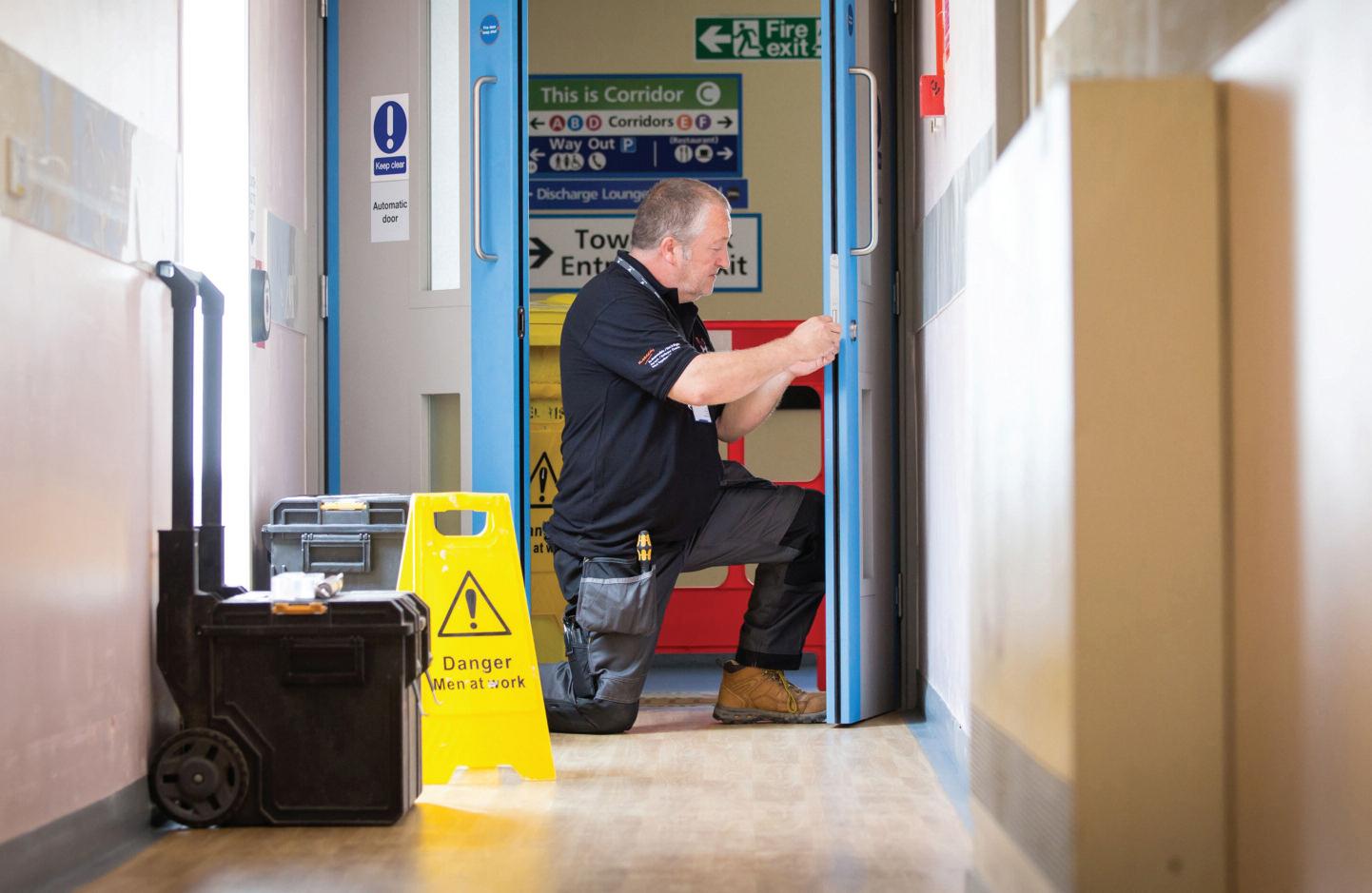


How
19


22
25
28
A

Issue Head on Advice on repurposing existing hospital spaces to increase theatre space
16 Tackling Healthcare’s Theatre Space
occupants Safe What to consider when selecting heat emitters for hospitals and healthcare facilities
Round-up
Keeping
21
Maximising Inclusivity in the Bathroom Creating inclusive bathrooms and the benefits of specifying RNIB Tried & Tested accredited showers
Wheelchair Accessible Kitchens in Practice
kitchen design advice with best practice tips from occupational therapists
Accessible
Round-up CONTENTS A P R I L / M A R C H 2 0 2 4 L A B M I 3
Redefining tenant engagement | 14 Creating accessible kitchens | 25 Working with specialist contractors to increase theatre space in existing hospitals | 16 SCHOOLS, HOSPITALS & PUBLIC BUILDINGS KITCHENS, BATHROOMS & DISABILITY NEEDS
Addressing ‘Hard to Treat’ Social Housing
29
social
insulate residents living in ‘hard to treat’ properties from fuel poverty
Leading Role for EWI
insulation’s
retrofit agenda
Driving Sustainability Solutions for Social Housing
housing providers can
33
External wall
role in the UK
36
single
37 Round-up 38 Escaping the Ghosts of the Past: The Rise of the UK’s offsite sector Why it’s important to make sure the positives don’t get forgotten when we think about modular and offsite
Innovative Design Platforms LABM finds out how Laurence Calvert Academy’s construction benefited from an innovative modular platform design system 42 Round-up April/March 2024 Vol 40 No 2 ROOFING, CLADDING & INSULATION MODULAR & OFFSITE CONSTRUCTION
source strategy approach to delivering sustainable social housing
40

Editor
Claire Clutten
labm@hamerville co uk
Advertisement Manager
Dave Jones
dave@hamerville co uk
Group Advertising Manager
Craig Jowsey
Digital Manager
Jasmine Smith
JSmith@hamerville co uk
Digital Assistant
Toby Richardson trichardson@hamerville co uk
Design
Adeel Qadri
Production Assistant
Claire Swendell
Group Production Manager
Carol Padgett
Circulation Manager
Kirstie Day
Printed by Stephens & George
Published by Hamerville Media Group
Regal House, Regal Way, Watford Herts WD24 4YF 01923 237799
Email: labm@hamerville co uk

© 2024
Subscriptions

To
In early March, Chancellor Jeremy Hunt announced his Spring Budget and it was hugely disappointing to see so little directed towards housing What a missed opportunity to tackle the housing crisis Whilst his support for families on the lowest incomes through the extension of schemes such as the Household Support Fund is a welcome move, which will provide some much needed relief for those struggling with the rising cost of living, his budget was sadly lacking in other key areas, for example support for the councils and housing associations at the frontline of tackling the homelessness crisis
Kate Henderson, Chief Executive of the National Housing Federation commented: “With child homelessness at record levels and one in six children growing up in overcrowded homes with little space or privacy, urgent and meaningful action on housing is needed
“This housing crisis can be solved but it requires a change of approach The Government must put an end to short-term thinking and piecemeal policy decisions and commit to a national long-term plan for housing which aims to deliver the secure, affordable, high-quality homes local people need ”
The Chartered Institute of Housing’s preBudget submission called for “urgent action to boost housing supply, invest in homelessness prevention and decarbonise the residential sector” Chief Executive Gavin Smart says, “these calls remain and we’ll continue to push the Government to go further”, adding, “ we need a sustainable housing system to support a vibrant economy ”
In February, Shelter and the National Housing Federation released a new report conducted by the Centre for Economics and Business Research (CEBR), highlighting the economic benefits of investing in social housing According to the research findings, ‘the next government could add £51 2bn to the economy, including £12bn profit to the taxpayer, by building 90,000 social homes a year ’
‘The economic impact of building social housing’ report cites the immediate and longterm value for money for the Government and the economy For example it highlights how investing in building 90,000 social homes a year would support 140,000 jobs in the first year
alone, ‘and within three years, return £37 8bn back to the economy, largely by boosting the construction industry’ Benefits to the taxpayer include £4 5bn savings on housing benefit, £5 2bn savings to the NHS and £4 5bn savings from a reduction in homelessness
On the release of the report, Peabody Chief Executive Ian McDermott said: “With its Spring Budget just around the corner, the Government has the power to put forward a plan that addresses growing homelessness while simultaneously providing a much-needed boost to the economy ” However any plans to tackle the homelessness emergency and boost economic activity through social housing investment were sadly lacking from the Budget
“The Gover nment must commit to a national long-ter m plan for housing ”
Recently, the Government announced the concerning decision not to extend its policy allowing local authorities to keep 100% of the money raised from Right to Buy sales receipts beyond March into the 2024-25 financial year As London Councils rightly warns, this “will undermine efforts to deliver desperately needed replacement homes”
In the capital alone, there are over 30,000 Londoners on waiting lists for social housing, the homelessness crisis is worsening and temporary accommodation costs pose a real risk to the financial stability of London Boroughs London Councils’ Executive Member for Regeneration, Housing & Planning, Cllr Darren Rodwell says: “The Government should be doing everything it can to boost boroughs’ ability to invest in new social homes but instead we could see our funding reduced ”
In March, the National Housing Federation launched the next phase of its campaign #PlanForHousing, calling for the next government to prioritise the building of social housing Let’s hope the next government recognises the economic, social and environmental benefits of delivering more social homes and commits to a long-term #PlanForHousing



A P R I L / M A R C H 2 0 2 4 L A B M I 5
M i s s e d o p p o r t u n i ty EDITOR’S COMMENT An innovative modular design platform was used to create the Laurence Calvert Academy in Leeds More details on page 40 COVER STORY:
MON UK MA / P 2024 LOCA HOR TY D NG & MA NT NANCE HOW d - d M D O MES Ad g p g h CHOOLS SP TALS B C BU GS RO NG CLA G & NSU ON ODULAR FS TE CO RUCT O K CH BATHRO S & D SAB Y NEEDS
are available at the following rates: UK: 1 year £30 00 post paid Europe and Overseas: 1 year £50 00 post paid Airmail: 1 year £65 00 post paid 12,224 (1 July 2022 30 June 2023)
to LABM
be removed from LABM’s circulation please call 01923
or email: circulation@hamerville.co.uk
237799
NEWS


Heat networks funding
£3 5m has been awarded in Round 4 of the Government’s Heat Network Efficiency Scheme (HNES) to 20 local authorities, housing associations, NHS trusts, universities and private sector organisations The funding aims to improve the performance of heat networks, so they provide better services to their customers, increased efficiency and reduced energy costs
Economic benefits of investing in social housing
l £3 8bn income from employment taxes
l
This latest announcement of £3 5m will positively impact 25 heat networks across England and Wales, benefiting 5,700 residents, including students, hospital patients, and other private and public sector occupants This brings the total funding awarded under HNES to over £28m Furthermore, capital grant funding will result in annual carbon savings of over 422 tCO2e per year over the next 40 years and revenue grant funding will also enable optimisation studies, identifying opportunities for additional carbon savings in the coming years
VIVID maintains top regulatory ratings
VIVID has maintained its G1 V1 ratings by the Regulator for Social Housing This achievement follows an in-depth assessment by the regulator and is the highest governance and financial viability rating that can be awarded
Mark Perry, Chief Executive of VIVID, says: “As a leading provider of affordable homes and support services in the south of England, we ’ re delighted to have maintained our G1 V1 ratings from the RSH These ratings reaffirm our ability to achieve our vision of ‘More homes, bright futures’ and our plan to continue to build trust, pride and impact for the benefit of our customers ” ©chrupka/AdobeStock

According to research conducted by CEBR for Shelter and the National Housing Federation, the next government could add £51 2bn to the economy, including £12bn profit to the taxpayer, by building 90,000 social homes a year The findings are presented in ‘The economic impact of building social housing’ report
The report delves into the significant economic and social benefits of building 90,000 social homes a year necessary to help fix the housing crisis and end homelessness It demonstrates how building this level of social homes a year would provide both immediate and longterm value for money for the Government and the economy, for example directly supporting nearly 140,000 jobs in the first year alone, and within three years, return £37 8bn back to the economy, largely by boosting the construction industry
T
l
l
I a n M c D e r
o t
, C h i e f E x e c u t i v e o f Peabody, comments: "More money from the Government would help fund more social rented homes and be transformative in a number of ways, addressing a range of social and economic issues It would also ultimately be cheaper for the taxpayer, saving councils vast sums on temporary accommodation, and reducing the amount of housing benefit that goes directly to private landlords
“We could begin to tackle the housing crisis, taking people out of poverty, boosting health and stimulating supply chains, while driving sustainable growth The whole country would benefit from tens of thousands of new jobs and billions more pumped into the economy ”
A copy of the report is available to download here www rdr link/laq001

r e p o r t a l s o h i g h l i g h t s h o w d e l i v e r i n g m o r e s o c i a l h o u s i n g w o u l d g e n e r a t e h u g e s a v i n g s f o r t h e t a x p a y e r a c r o s s m u l t i p l e d e p a r t m e n t s : l £ 4 5 b n s a v i n g s o n h o u s i n g b e n e f i t l £2 5bn income
construction
h e
from
taxes
n s a v i n g s t o
h
H S
£ 5 2 b
t
e N
5 b n s a v i n g s f r o m r e d u c t i o n i n h o m e l e s s n e s s
£ 4
b n s a v i n g s t o U n i v e r s a l C r e d i
£ 3 3
t
m
t
IN BRIEF
Helping South London rise to Net Zero challenge

impact Data metrics (iDm), the leading data provider to local authorities and economic development bodies, has completed a trailblazing project to identify the businesses which will help hundreds of thousands of properties in South london decarbonise
Working for the South london partnership, a subregional collaboration of six london boroughs, iDm has used its industry-leading, machine-learning powered software, iDm Business, to map where across the subregion the businesses are that can deliver retrofit to 635,000 homes and commercial premises
iDm’s research has enabled Slp to establish not only where across, croydon, Sutton, merton, Kingston Upon Thames, richmond Upon Thames and Wandsworth, the businesses are physically located, but also their specific trades, be they electricians, heating engineers, plumbers, roofers or glaziers
it has mapped out the number of people these companies employ, how long they have been trading and even their financial health
Geoff Wainwright, chief Executive of iDm says: "The whole retrofit Net Zero drive is a big challenge and a big opportunity in these six boroughs the market opportunity is very significant to deliver the necessary retrofit improvements to existing buildings the sector is going to have to grow substantially with more than 66,000 full-time equivalent jobs needed by 2030, but the opportunity is there to be unlocked ”
The research undertaken by iDm was funded by the Department for Energy Security and Net Zero via the Greater South East Net Zero hub
Retrofit Insulation Insights with

Aerogel insulation



arguably the biggest challenge on a retrofit or refurbishment project is accommodating new or additional insulation within existing constructions Space constraints especially on the inside of buildings where room sizes might already be limited make substantial insulation thicknesses almost impossible, limiting improvements in overall thermal performance
These constraints are even more pronounced at critical thermal bridging details Widely used ‘conventional’ insulation products are simply too thick to accommodate But making insulation improvements elsewhere without addressing thermal bridges can worsen the risk of condensation and mould occurring at those details
What is aerogel insulation?
Originally manufactured for the aerospace industry, aerogel is a material where the liquid in the gel is replaced by gas, without shrinking, by a complex process called super-critical drying The resulting material is rigid and offers excellent thermal properties it is also brittle, so embedding it into a carrier fabric, like polyester or glass fibre, creates a flexible blanket material that is more usable, as it better maintains its integrity and thermal performance
Why is Spacetherm A1 ideal for retrofitting buildings?
a proctor Group’s aerogel blanket product, Spacetherm a1, has a very low thermal conductivity of 0 0195W/mK, so high levels of thermal efficiency can be achieved in space-critical applications
The thermal performance of ventilated facades can be enhanced generally, and in areas of thermal bridge detailing such as window reveals and steel beams and with a non-combustibility classification of a1, façade systems can be optimised for fire performance too
Whether installed internally or externally, buildings can also benefit from the material’s moisture management characteristics, including vapour permeability and hydrophobicity
Spacetherm is a proctor Group’s range of ultra-thin insulation solutions for retrofit and new-build projects We offer a variety of solutions featuring Spacetherm a1, including ones bonded to plasterboard or magnesium oxide board to suit different applications
John Johnston, Sales Director at A. Proctor Group, discusses how your retrofit project could benefit from aerogel insulation
m a r c h / a p r i l 2 0 2 4 l a B m i 7 n Find out more at www rdr link/laq002
Kilmarnock council housing development underway
The first homes of an innovative council housing development in Kilmarnock are now under construction for East Ayrshire Council by their strategic developer, CCG (Scotland) The 48 dwellings on Kennedy Drive are designed to meet a range of needs for people including general needs, wheelchair accessible and older ambulant disabled residents
The scheme is also the third and largest development designed to achieve (regulated) operational net zero carbon Regulated operational energy is that which is consumed by the building and its controlled fixed services and systems, such as heating, hot water, cooling, ventilation, fans, pumps and lighting
CCG’s expertise in the manufacture of timber systems super-insulated wall zones integrated with their own tripleglazed windows and enhanced doorsets will create an advanced building fabric that will naturally retain warmth and reduce heat loss as well as lowering energy consumption The combination of these measures means the homes are compliant with upcoming changes to affordable housebuilding standards in Scotland and tackle fuel poverty
We acknowledged that with changes to Building Regulations, brought forward by the Scottish Government’s Climate Change Act, we had to have a practical, scalable and affordable solution that addressed the removal of gas heating systems which will prohibited in new-build homes from 1st April 2024
“This resulted in the creation of the ‘CCG Net Zero Home’, a building standard that is oven-ready to these forthcoming legislative requirements and one which has been used to deliver over 600 homes since its launch in 2021

To achieve net zero emissions from regulated energy, each home utilises a range of renewable technologies including the installation of air source heat pumps and solar PV panels that will be installed on each roof
CCG Managing Director, David Wylie, says: “Kennedy Drive will be the tenth development that CCG, in partnership with MAST Architects, will have delivered on behalf of East Ayrshire Council in the last seven years and it is the latest example of how collaboration and housing-led regeneration is delivering real change in communities like Kilmarnock
“CCG’s experience in the applied research of net zero dates back to 2019

“ O u r a p p l i e d r e s e a r c h h a s n o t o n l y h e l p e d c l i e n t s b e g i n t h e i r t r a n s i t i o n t o n e t z e r o e a r l i e r , i t h a s h e l p e d c r e a t e a f u t u r e - p r o o f m e t h o d o f a d d r e s s i n g l o c a l i s e d h o u s i n g n e e d a n d d e m a n d a c r o s s t h e b r e a d t h o f t h e c o u n t r y ”
The project is being developed with £5 147m of grant funding from the Scottish Government
PROJECT UPDATE NEWS:
8 I L A B M M A R C H / A P R I L 2 0 2 4


B u d g e t m i s s e s t h e m a r k f o r h o u s i n g
The Budget another missed opportunity to fix the housing crisis, says Matthew Warburton, Policy Advisor at the Association of Retained Council Housing (ARCH)
Forecasts of only sluggish growth for the UK economy left Chancellor Jeremy Hunt unable to deliver significant tax cuts or new investment to please Conservative backbenchers or win back lost support in the forthcoming General Election The underwhelming announcement of a further 2% cut in national insurance contributions only emphasises how little scope he had for the traditional Budget surprise
Concern about the continuing high level of public debt was probably responsible for the absence of any reference to affordable housing in the Chancellor’s speech Despite clear evidence that building more social housing could help boost the economy as well as fix the housing crisis, the Treasury seemingly remains wedded to the belief that all public borrowing has the same economic impact This is a uniquely British misconception; other countries draw a clear distinction between borrowing that must be repaid from taxes, and borrowing to invest in assets that yield predictable returns
Research commissioned by ARCH and others over the last decade has shown beyond reasonable doubt that a big new programme of council housebuilding would yield substantial gains to the Exchequer in a relatively short time, by enabling savings on temporary accommodation and benefit payments to private tenants, not to mention
broader economic and social benefits The latest example was published last month by the Centre for Economic and Business Research, for Shelter and the National Housing Federation It shows that the next government could add £51.2bn to the economy, including £12bn profit to taxpayers by building 90,000 social homes
The small print
The only new policy relevant to council housing is buried deep in the small print of the Budget documentation It is the announcement of “additional flexibility" for councils in the use of Right to Buy receipts an increase in the percentage of the cost of a replacement home that can be funded from receipts from 40 to 50% This is a change that ARCH has been pressing for ever since building costs started to accelerate in the aftermath of the COVID pandemic simply to reflect the impact of these costs, and the subsequent increase in interest rates.
While this concession is welcome, its effect will be largely cancelled out by the Government’s decision not to extend the two-year period which ends on 31st March during which councils have been allowed to retain and reinvest all their RTB receipts We are still a long way away from policies that enable councils to deliver one-for-one replacement of homes sold under RTB

“ D e s p i t e c l e a r ev i d e n c e t h a t b u i l d i n g m o r e s o c i a l h o u s i n g c o u l d h e l p b o o s t t h e e c o n o my a s we l l a s fi x t h e h o u s i n g c r i s i s , t h e Tr e a s u r y s e e m i n g l y r e ma i n s we d d e d t o t h e b e l i e f t h a t a l l p u b l i c b o r row i n g h a s t h e s a m e e c o n o m i c i m p a c t . ”
Unable to build at the scale demanded by housing needs, and unable to replace the homes they have to sell under RTB, councils are faced with the impossible task of reconciling their duty to house growing numbers of homeless households, not to mention hundreds of thousands of applicants waiting for a council house, with the supply of housing at their disposal. But instead of helping address the underlying causes of this problem, the Government has chosen to consult on changes to allocations policy which sound well in some ears more priority for British applicants but will make very little difference to who gets housed, and none at all to the number of homes available.
www.arch-housing.org.uk

INDUSTRY COMMENT IN ASSOCIATION WITH
1 0 I L A B M M A R C H / A P R I L 2 0 2 4


RETROFIT SKILLS CHALLENGE in association with
Gap in the market
As more social housing providers and local authorities look to make efficiency upgrades to properties through the Social housing Decarbonisation Fund (ShDF) and home Upgrade Grant (hUG), the demand for retrofitters is rising
With more and more homes having the potential to receive sustainable upgrades, it is imperative that knowledge and skills provisions are accessible to both businesses and individuals The retrofit revolution is here, but what does that mean for those involved?
Addressing the skills gap
Those looking to take on the challenge need to understand what the retrofit roles are and where their skills gaps lie retrofit advisors, assessors, and coordinators are all vital in ensuring a project is completed to the highest of standards as well as on time a successful, high quality retrofit department or business relies on these roles, and teams being trained for leading qualifications
When building a retrofit team within a business, it is important to know how many people you need to undertake the expected number of projects Whether 10 homes or 10,000, understanding the workforce required will ensure that targets and deadlines can be met Tools such as The retrofit academy’s Workforce modelling system can make this more transparent
Businesses looking to get into the retrofit space may find that they already have individuals on their team capable of
learning new skills to undertake a retrofit role The retrofit academy’s Training Needs analysis Tool can help employers identify suitable candidates and create a tailor-made programme to train employees and satisfy the skill demand
With a clear idea of the workforce requirement and training needs, decision makers may also need to make external hires Dedicated retrofit employment platforms, such as the retrofit academy’s careers hub, allows employers to connect qualified professionals in the industry
Learning retrofit
accessing high-quality education is the next step in closing the skills gap By partnering with a training provider and developing a positive working relationship, quality education goes beyond simply offering courses Furthermore, by addressing the skills gaps together, the training models used can be adapted as the business continues to grow
The retrofit academy has led the charge for retrofit education since it opened its doors in 2016, paving the way for individuals to enter this space Our accredited courses such as the level 2 in Understanding Domestic retrofit all the way up to the level 5 in retrofit coordination and risk management
Diploma allow individuals to learn the full breath of the retrofitting industry as we look to close the skills gap, these courses allow individuals and businesses to better understand retrofit and deliver programmes to a high quality and at scale


T h e f u t u r e o f r e t r o f i t : w h a t i s
b e i n g d o n e t o m e e t gr ow i n g
d e m a n d ? W i t h d e m a n d fo r
q u a l i f i e d r e t r o f i t t e r s
c o n t i nu i n g t o b o o m , J e n ny
P i e r p o i n t , C h i e f O p e ra t i n g
O f f i c e r a t T h e R e t r o f i t
A c a d e my, ex p l a i n s h ow l o c a l
a u t h o r i t i e s a n d s o c i a l
h o u s i n g p r ov i d e r s c a n
a d d r e s s t h e i r s k i l l s g a p s
“Dedicated retrofit employment platfor ms , such as the Retrofit Academy’s Career s Hub, allows employer s to connect qualified professionals in the industr y.”
Our newly launched retrofit 101 course has been tailor-made to give an initial introduction to retrofit, allowing participants to understand the fundamental basics of the industry This is perfect for those exploring new career opportunities, looking to enhance their skills set, and even senior decision makers wanting to understand the new branch of their organisation
Through our courses, we have trained 4,000 professional retrofitters and onboarded over 7,000 learners as the driving force in retrofit knowledge and skills, The retrofit academy is on a journey with local authorities, social housing providers and contractors to address the retrofit skills gap and help the UK achieve net zero
n For more information about The Retrofit Academy, please click www.rdr.link/laq003

m a r c h / a p r i l 2 0 2 4 l a B m i 1 1


F o c u s o n d o m e s t i c r e t r o f i t a n d d e c a r b o n i s a t i o n
FOOTPRINT+, the UK’s most advanced event for decarbonising buildings, announces a cutting-edge agenda and speaker line-up for the 2024 show in May, with plenty on offer for local authorities.
Constantly evolving, the show has set a precedent in the UK delivering affordable energyefficiency solutions to retrofitting council buildings and existing housing stock
At this year ’ s event, Architect John Christophers will be describing how he and his wife Jo Hindley overcame the hurdles to delivering domestic retrofit in Balsall Heath, where 649 houses have been retrofitted at no cost to the homeowners John and Jo worked with Birmingham City Council to
“
” I’ve been really impressed with FOOTPRINT+, the sheer amount there is available to learn Bring people from across your organisation, not just the senior leaders. Your workforce can learn a lot from the conference, ask questions and get into the detail of how to deliver on the objectives that we are all tr ying to pursue.
Nicola Beech, Cabinet Member with responsibility for Strategic Planning, Resilience & Floods at Bristol City Council

access Local Authority Delivery Phase 3 funding to deliver the project Harnessing the economies of scale, which contractors can offer when working on more than one house within a small area, they are replacing windows and doors, fitting loft insulation and draft excluders and improving ventilation
Retrofit Balsall Heath is a team of volunteers led by Architect John Christophers, who says: “If you get the whole street doing it then the efficiencies for the contractors are great ” The scale of funding needed to retrofit the UK’s 29 million homes has been estimated at between £300-£600bn
SHOW PREVIEW: FOOTPRINT+ LONDON
Over 60 sessions will be delivered across seven stages over two days

We l o o k
f o r w a r d t o w o r k i n g
w i t h F O O T P R I N T + o v e r t h e m o n t h s a n d y e a r s t o c o m e .
Lord Callanan, Minister for Energy Efficiency and Green Finance at the Depar tment
for Energy Security and Net Zero
“
The

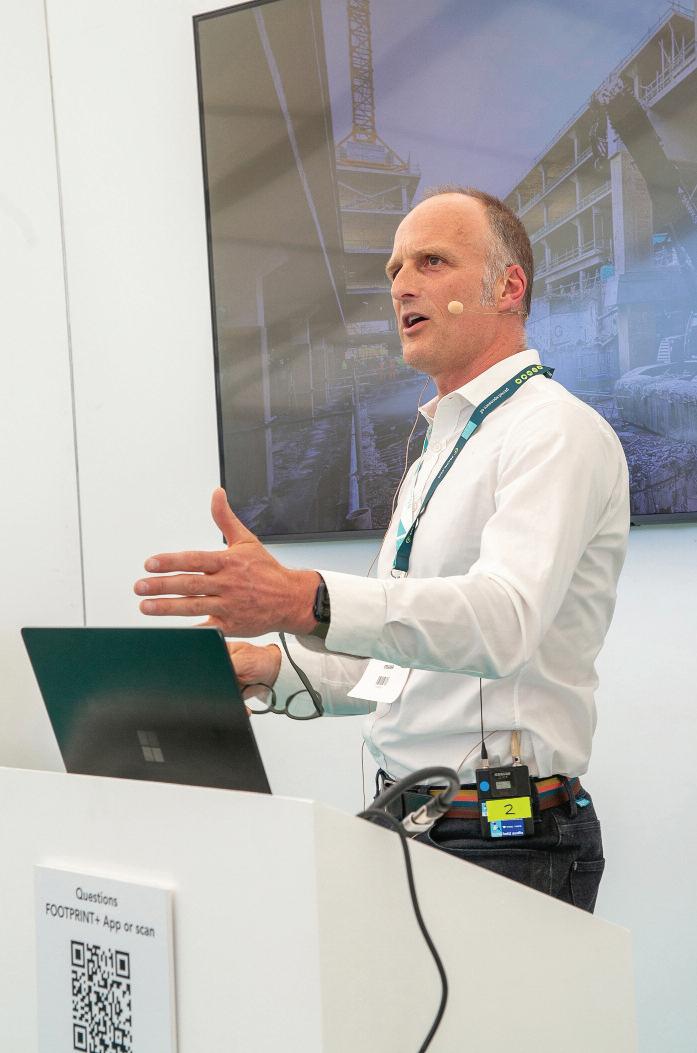
Last year's event was a fantastic oppor tunity for us to engage with like-minded professionals
and learn about the challenges being faced
across the industr y. FOOTPRINT+
presents
a fantastic platform for us to demonstrate our capabilities and offer suppor t to a wide range of client groups
Andrew Money, Founding Director at Carbon Futures
“ ”
The conversations going on here are not regurgitations of impor tant messages, they are moving for ward discussions — that feels impor tant If you ’ re someone who’s tr ying to make a difference it’s well wor th being here so that your voice is a par t of that ver y contemporar y discussion.
Chris Clarke, Per formance and Improvement Director at SCAPE
Conference programme
Attending FOOTPRINT+ local authority delegates will also be able to take part in a variety of thought-provoking presentations, these include:
l Access to air: Making heat pumps work discussing Hillingdon Council’s Civic Centre decarbonisation
l Breathing life into a 1930s leisure centre with Westminster City Council
l BNG in dense urban environments with Samuel Evans, Greater Manchester Combined Authority
l Retrofit-first planning policy with Kerstin Kane, Principal Planning Officer, City of London
”l The role of procurement in driving change with Fergus Harradence, Department for Business and Trade
l Not fit for purpose: Busting the myth with Edward Jarvis, Camden Council
FOOTPRINT+ London will be taking place on the 8th and 9th May in Old Billingsgate, London The event gives local authority delegates FREE access to over 60 sessions on seven stages over two days

n For more information about FOOTPRINT+ London and to book your complimentary tickets visit www.footprintplus.com
n For more information about attending contact katherine@footprintplus.com
l
h e r o l e o f p u b l i c s e c t o r i n g a l v a n i s i n g c i r c u l a r e c o n o m y w i t h N o r f o l k C o u n t y C o u n c i l
T
M A R C H / A P R I L 2 0 2 4 L A B M I 1 3
“ ”
event offers a variety of thought-provoking conference sessions
The exhibition provides an ideal opportunity for visitors to connect with key organisations involved in sustainability and decarbonisation

U n l o c k i n g a c c e s s w i t h t e c h n o l o g y
Gary Haynes, Managing Director of Voicescape a software business, which provides resident engagement solutions for social landlords and local authorities considers how technology could hold the key to no-access
The social housing landscape has changed considerably in recent years, with significant legislative change that has placed building and resident safety, together with amplifying the voice of the resident, front and centre of reforms
The introduction of the Social Housing (Regulation) Act 2023 has set the tone for how the sector will be regulated moving forward In essence, the Act has been designed to drive up standards and bolster the regulator’s power to act
The changes are decisive social landlords, whether private or local authority-led, face unlimited fines for noncompliance and stronger powers have been given to the Regulator of Social Housing to act where necessary, with the cost forwarded on to the landlord
Secretary of State for Levelling Up, Housing and Communities, Michael Gove hailed the Act as “landmark” laws that will “drive up standards of social housing and give residents a proper voice ”

Michael Gove said: “The Social Housing Act will help to ensure that tenants get the safe, warm and decent homes they deserve and those who have seriously neglected their responsibilities for far too long will face the consequences ”
For social housing providers and local authorities, this major reset of power between tenants and landlords is a significant step-change and one that shines a spotlight on compliance like never before
However, the elephant in the room, and the increasingly difficult challenge being faced by the sector, is the issue of noaccess when gas and electrical safety checks are due The cost and responsibility on landlords, not only to remain compliant, but also to reduce the cost and occurrence of no-access is massive
Three key stakeholders are at play: the tenant, the Government, and the social landlord The driver for tenant safety, welfare and wellbeing is shared across all three, yet the issue of no-access and the
responsibility to develop methods to overcome this falls on the landlords alone along with the heavy cost of failure
Embracing change
In order to meet the Government’s ambitions to drive up standards, and achieve the collective aim to create safer homes for residents, the sector needs to be bolder and work smarter Manual processes are time intensive and will only serve to take organisations so far The key to improving services and tackling the issue of no-access is to embrace and make better use of digitisation, automation and behavioural insight to create


SPECIAL REPORT: RESIDENT ENGAGEMENT SOLUTONS
Image
credit Teamjackson
Image credit NiroDesign
efficiencies, streamline processes, and guide decision-making Stronger engagement with residents will also be crucial, empowering them in the appointment booking process, enabling them to have their say and making them feel invested in the decision-making Doing this will help to gain the first-time access needed to maintain compliance, while taking it a step further in understanding and, to an extent, predicting future behaviour
There’s no doubt that the hands-on aspect of building maintenance, repairs and safety inspections is not typically associated with digital transformation Fixing problems and quality checks rely on in-person expertise and onsite experience, which isn’t always possible to replicate remotely But in today’s economic and social climate, digitisation is evolving maintenance and safety services
Organisations have been forced to think differently and adopt new ways of managing gas and electrical safety inspections and maintenance work, in order to crucially get across the threshold and gain access to housing stock It’s about turning challenges into opportunities to improve efficiencies, as well as resident satisfaction But how does it work in practice?
No access, no compliance
Social landlords face a tough task of ensuring they can access resident homes to complete works and checks This is even more challenging for those local authorities that are responsible for tens of thousands of homes Organising appointments can prove more challenging than the actual maintenance and inspections it’s a colossal job that requires significant resource
To overcome the problem of no access to homes, social landlords have tended to use traditional prescriptive engagement methods such as sending letters and text messages informing tenants of a fixed date, which often lead to low engagement and high rates of no-access Consultative engagement methods, meanwhile, are expensive, complex and time intensive
Embracing digitisation has changed these conventional processes and brought together the best of both worlds It finds the middle ground between the two


approaches and crystallises the benefits of each By automating the process of booking, confirming and rescheduling appointments with tenants, residents are informed of safety visits, such as annual gas and electrical installation safety checks, well before they happen
By getting it right the first time, Registered Social Landlords (RSLs) can build trust and satisfaction with tenants all without the costs and inefficiencies associated with manual outbound calls and wasted visits (which are estimated to cost between £75 and £100 each)
As well as supporting a more efficient, resident-focused appointment-booking approach, it can also help organisations align with the new consumer standards, which call for the use of data to design services around customer needs Integrating automation technology, data analytics, and behavioural science principles, simplifies the previously manual, complex, and laborious process of engaging at scale
Beyond compliance
Compliance and regulation is clearly where the national spotlight is pointing at the moment, with access being both the problem and the solution for many There’s no denying that it’s a major priority for social housing providers and local authorities too, given that everyone has to be compliant
But there are other competing priorities at play some of which link to legislation and others that underpin internal performance and workforce stability These include: increasing customer engagement and connecting
with them to greater understand their needs; increasing customer satisfaction to give them more of a choice about when and how their landlord engages with them; meeting SLAs and KPIs to maintain internal performance and partnerships with other organisations; reducing cost to serve, so that organisations can reinvest into services and properties; as well as future-proofing services by moving with the times and the latest technologies
Finding a separate solution for each individual priority is not a practical approach However, when the compliance process is examined more thoroughly and viewed beyond just fulfilling regulatory requirements, there’s a chance to gain advantages that extend across various areas of the organisation
As the regulatory pressures and penalties heighten around non-compliance, it’s clear that improving tenant safety through engagement has become evermore crucial for the social housing sector The direct and indirect costs associated with no-access are enough to make any organisation want to strive for change But first the sector has to see compliance as an opportunity to improve the way it connects with households not only to meet new legislation, but to make headway on other priorities too

n For more information on redefining tenant engagement to reduce the costs associated with no-access, read Voicescape’s latest whitepaper here www.rdr.link/laq004
M A R C H / A P R I L 2 0 2 4 L A B M I 1 5
Image credit yunava1

As the healthcare sector continues to adapt for a post-pandemic future, increasing the amount of theatre space will play a vital role in reducing waiting lists and resuming more desirable service levels Here, Lee Spencer, Head of Operations – Major Projects at Novus Property Solutions, discusses how working with specialist contractors to temporarily or permanently repurpose existing hospital spaces can offer the ideal solution to the theatre space issue.


Ta c k l i n g h e a l t h c a r e ’s t h e a t r e s p a c e i s s u e h e a d o n
Bu d g e t r e s t r i c t i o n s a n d s t a f f s h o r t a g e s h a v e l o n g b e e n r e c o g n i s e d a s k e y c h a l l e n g e s f o r t h e N H S , r e s u l t i n g i n g r o w i n g d e l a y s t o t r e a t m e n t f o r p a t i e n t s T h e s e i s s u e s w e r e f u r t h e r e x a c e r b a t e d b y t h e o u t b r e a k o f C o v i d - 1 9, w h i c h f o r c e d a r e d u c t i o n i n p l a n n e d s u r g e r i e s a n d o t h e r n o n - u r g e n t p r o c e d u r e s i n t e n s i f i e d b y t h e e x i s t i n g n u m b e r o f t h e a t r e s s i m p l y n o t b e i n g e n o u g h t o c l e a r t h e b a c k l o g e f f i c i e n t l y
Temporary measures
For any sector, the introduction of shortterm measures is often necessary to overcome urgent challenges Healthcare is no exception, and we saw the use of temporary solutions quickly implemented in response to the pandemic This strategy can be applied to the theatre space issue, where supply simply isn’t meeting demand but Trusts are facing severely limited budgets
Portable for-hire mobile units are a popular temporary measure for hospitals trying to combat the escalating waiting lists These mobile units can offer an ideal interim solution thanks to their versatility, which saw them used for a variety of
purposes during the pandemic including as short-term vaccination centres This flexibility of use means that mobile units can be easily installed into any well-sized space such as car parks, and fitted with the equipment required for a theatre
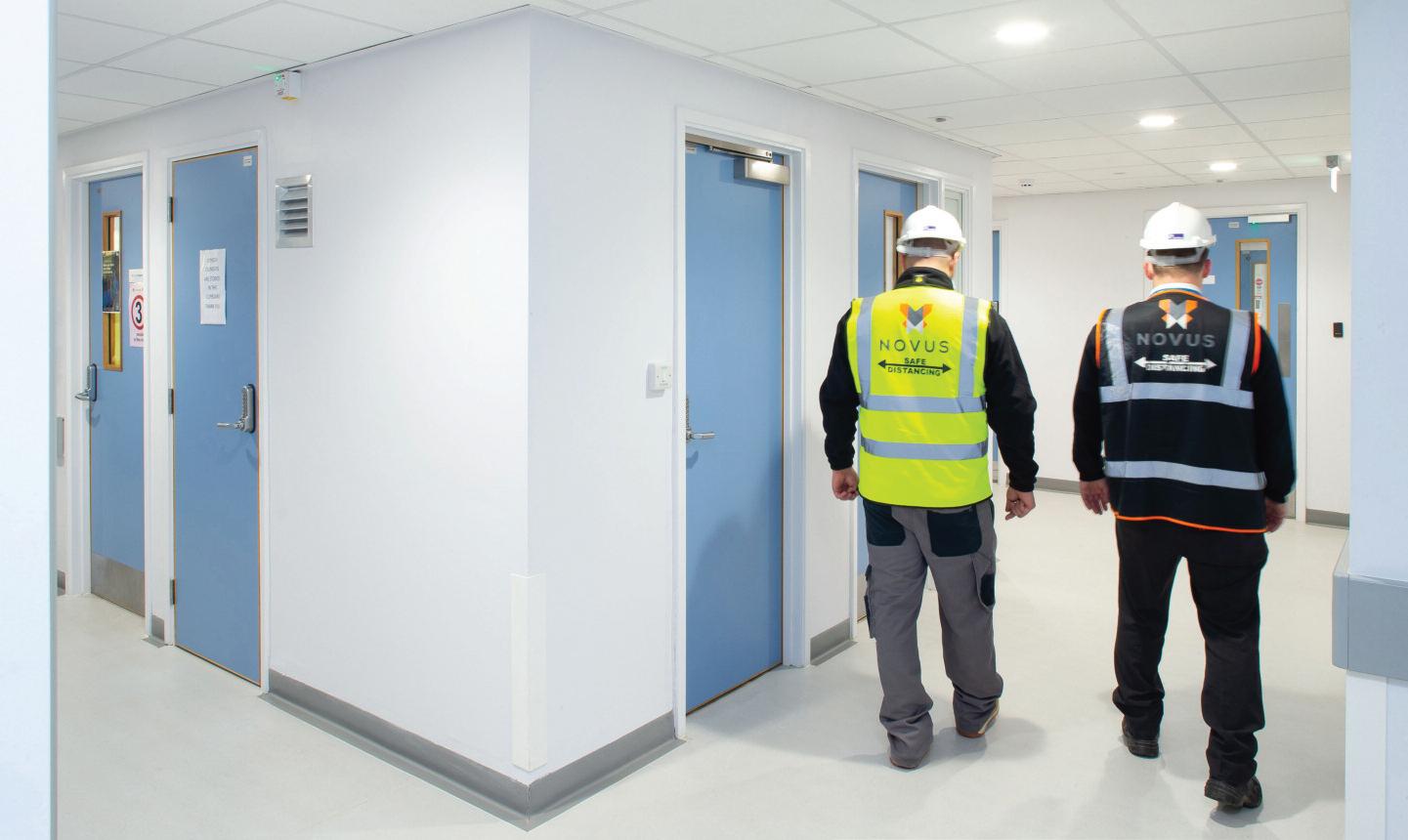
SCHOOLS, HOSPITALS & PUBLIC BUILDINGS


Permanent solutions
While temporary measures such as mobile units are arguably necessary in the current climate, it’s important to note that they are unlikely to be effective in the long-term With this in mind, steps must be taken to future-proof theatre spaces and provide practical, permanent solutions for reducing waiting lists as a priority
It’s clear that Trusts need to invest in theatre space and ideally new theatres would be built, but this often isn’t possible due to space or budget restrictions and it certainly isn’t a quick option
An alternative solution is to maximise the useability of existing theatre spaces, by upgrading them to expand their capabilities For example, adding ultraclean ventilation canopies to make a theatre suitable for orthopaedic surgery is a relatively cost-effective way to increase how a space can be used
Another option is to create new theatres in underused areas of the hospital Many office-based hospital staff began working remotely in response to Covid-19 and this way of working remains commonplace, leaving these often large spaces not used to full capacity It therefore makes sense to convert at least part of these areas into theatres, offering an ideal middle ground between temporary measures and the creation of new buildings
This method has already been successfully implemented in some NHS hospitals, where underused offices have
been repurposed as ward spaces, and can therefore be applied as a long-term solution for creating more theatre space
The value of specialist contractors
Whether the solution is temporary or permanent, choosing a trusted contractor with experience in the healthcare sector is key Engaging with a specialist contractor like Novus Property Solutions early in the process will maximise the value of the project, allowing Trusts to draw on its expertise as well as reducing delivery timeframes as the contractor is able to develop the works on site during the design process
Specialist contractors will also work closely with an established supply chain to support the delivery of any healthcarebased project, including upgrades to or the expansion of theatre spaces The guarantee of a strong supply chain also offers certainty of delivery and value for money ideal for Trusts operating with strict budgets
What’s more, the live nature of hospitals which largely operate on a 24/7 schedule means that the expertise of specialist contractors and supply chain partners is valuable beyond the delivery of the work itself: it’s crucial for ensuring projects are carried out safely, effectively, flexibly, and with compassion
Prioritising infection control is vital in hospital settings, where not only can infection spread quickly and easily, but also it can be detrimental to patients who may
“E x p e r i e n c e d
c o n t ra c t o r s w i l l
c o l l a b o ra t e w i t h e s t a t e s d e p a r t m e n t s a n d o t h e r
s t a ke h o l d e r s t o e s t a b l i s h a b e s p o ke s t ra t e g y fo r
m i n i m i s i n g c o n t ra c t o r-
p a t i e n t i n t e r fa c e t h ro u g h o u t t h e p ro j e c t . ”
be more vulnerable Contractors specialising in the healthcare sector are well-versed in infection control measures, from social distancing to effective waste removal
As well as implementing a robust infection control strategy, early engagement with a specialist contractor is also valuable in planning how the work will be carried out with minimal disruption to patients, staff and visitors
Experienced contractors will collaborate with estates departments and other stakeholders to establish a bespoke strategy for minimising contractor-patient interface throughout the project While this can’t always be completely avoided, this partnership approach will help to identify steps that can realistically be taken to reduce contact and disruption, such as site access through separate corridors or where this is not possible, utilising airtight plastic and drywall hoarding to fully divide working spaces temporarily Measures like these can be discussed during planning stages and subsequently built into the tailored commissioning programme
Working in collaboration with a specialist contractor offers significant value for any theatre upgrade or expansion project, promising expert advice, guidance and delivery When combined with the knowledge of estates departments, this expertise will allow programmes to be delivered on time, on budget, and right first time

M A R C H / A P R I L 2 0 2 4 L A B M I 1 7
n For more information on Novus Property Solutions services for healthcare, visit www rdr link/laq005
Whether opting for a temporary or permanent solution, choosing a trusted contractor with experience in the healthcare sector is key

Spencer Clark, Specification Sales Manager at Clyde Radiators, explores the key considerations when selecting heat emitters for hospitals, care homes and other healthcare facilities. He explains why low surface temperature (LST) radiators are the ideal solution for keeping occupants safe and comfortable.

Keeping occupants safe
When specifying heating solutions for the healthcare environment, the safety and wellbeing of patients, residents and staff must be the number one priority The heating system should provide a comfortable environment without posing any risk of harm to the occupants As a result, the choice of heat emitter needs to be carefully considered
Considering occupant safety
In spaces occupied by the more vulnerable, including patients, children, elderly or people with disabilities, radiators and heat emitters can potentially cause harm if they reach high temperatures In fact, both HSE and NHS Estates guidance state that surface temperatures should not exceed 43˚C in healthcare settings, to reduce the risk of injury Whilst the risk of injury may be small if someone brushes against the surface, if they fall into the radiator or hold onto it for more than a few seconds, for example to steady themselves, this could result in severe burns
Standard panel radiators can reach temperatures around 70˚C, making them unsuitable and unsafe for these environments Low surface temperature (LST) radiators are specifically designed not to exceed 43˚C, meeting the NHS Estates
guidelines Their outer casing encloses the heat emitter, ensuring a cooler exterior with minimal burn risk if touched
As well as surface temperature, the physical form of the LST radiator is an important safety consideration Models with rounded edges and corners help to protect patients from injury in the event of a fall or collision In addition, anti-bacterial coatings provide extra protection against the spread of infection, another vital consideration when specifying for healthcare facilities
Some LST radiators also feature pencilproof grilles that allow fluid convection and airflow whilst preventing patients and residents from coming into direct contact with the convector These grilles can also be anti-ligature to help prevent self-harm
Energy efficiency
As well as safety, energy efficiency is a crucial priority in healthcare settings In line with the commitment to environmental sustainability, all four health services in the UK announced their aim in 2021 to meet net zero targets ahead of the Government's 2050 goals With round-the-clock operation, heating bills can also strain already limited budgets, selecting energy-efficient models is therefore essential to control heating costs and improve overall sustainability

aluminium convectors, such as those made by Clyde, heat up rapidly thanks to aluminium’s high conductivity They also cool down quickly when the temperature is lowered This makes them very responsive, providing accurate localised heating control and reducing the amount of energy required to heat the room
In addition, their lightweight construction and one-piece casing makes LST radiators easier and quicker to install than steel alternatives This saves on project time and costs and keeps disruption to a minimum, allowing the medical facility to remain operational during installation In addition, there is the option to fit the convector at first fix stage and to follow up with the casing later; this helps meet the requirements of the build schedule
p
M A R C H / A P R I L 2 0 2 4 L A B M I 1 9 SCHOOLS, HOSPITALS & PUBLIC BUILDINGS
43˚C
Low
surface temperature (LST) radiators are specifically designed not to exceed
SCHOOLS, HOSPITALS & PUBLIC BUILDINGS



r based solutions
e wall space is limited, trench based ng where the system is installed in a trench in the floor is an excellent option These systems provide discreet heating from floor level, with minimal use of floor areas As occupants do not come into direct ontact with the units, floor-based heat mitters provide safer, more accessible eating For example, Clyde's Trench T uses an aluminium trench-type ector concealed at floor level; this ves any exposed hot surfaces, enting occupants from coming into act with any heated components while ding the necessary heat output he system delivers efficient underfloor ng and, in many cases, doesn’t require icant structural modifications Its tability in terms of depth, configuration grille options makes it an ideal choice verse aesthetic requirements and high areas such as atriums
Compliance and performance testing
When specifying any heat emitter, it’s vital to check its credentials For example, our Centurion has been tested independently at BSRIA and certified to BS EN442, the technical specification and requirements for radiators and convectors This guarantees thermal output and efficiency claims In fact, Clyde Radiators has a choice of options to meet an area ’ s individual needs
F o r h e a l t h c a r e s e t t i n g s , w h e r e p a t i e n t a n d r e s i d e n t c o m f o r t i s p a r a m o u n t , L S T r a d i a t o r s a r e i d e a l W i t h t h e c o r r e c t L S T r a d i a t o r s p e c i f i c a t i o n , h e a l t h c a r e f a c i l i t i e s , e s t a t e m a n a g e r s , a n d b u i l d i n g o w n e r s c a n b e c o n f i d e n t t h a t t h e y ' v e t a k e n e v e r y r e a s o n a b l e m e a s u r e t o p r o t e c t o c c u p a n t s w h i l e e n s u r i n g o p t i m u m c o m f o r t a n d e f f i c i e n c y
n To learn more about Clyde Radiators and its range of solutions for healthcare facilities, visit www rdr link/laq006

 Clyde Radiators Mini LST is easy to clean and a poor harbour for dust and micro-organisms
Clyde Radiators Mini LST is easy to clean and a poor harbour for dust and micro-organisms
SCHooLS, HoSPITALS & PUBLIC BUILDINGS RoUND-UP

NHS P23 approval
Altro has been appointed as a recommended supplier on ProCure23 (P23), the fourth generation of the ProCure framework for the design and construction of NHS capital projects With extensive Altro product ranges approved within the scheme, NHS partners can access a comprehensive offering encompassing smooth and safety floors with adhesive-free options, hygienic walls, wall protection, doors, wash stations and resin floors With up to 30-year product guarantees and a vast array of colours, the company can ensure healthcare buildings provide an impervious, hygienic and durable environment which is warm and welcoming, reducing stress and improving patient and staff wellbeing Altro offers a wide selection of floor solutions that can be used in all areas of health and care environments, including specialist safety solutions for areas with a high slip risk, including bathrooms and kitchens
n For more information on Altro’s range visit www.rdr.link/laq007
Importance of compliant fire door specification and inspections
To aid compliant fire door specification in hospitals, ASSA ABLoY opening Solutions UK & Ireland’s openings
Studio BIM application integrates with design software to create and visualise openings for complete door, frame and hardware schedules and specifications
This enables seamless extraction of door design intent and all relevant interfaces to assist the development of complete door requirements that meet Building Regulations Product information, performance data and budget information are captured within the BIM design environment
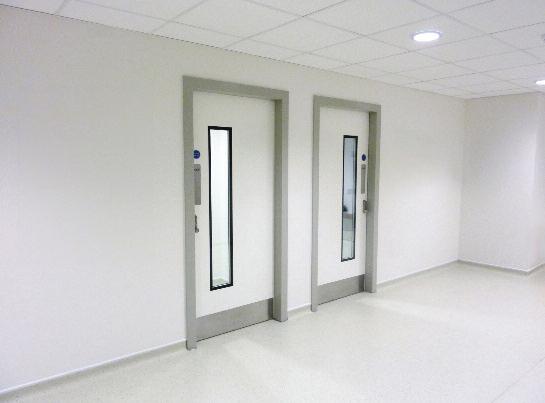
Through real-time, collaborative working, these designs can be validated for compliance, functional performance, and aesthetics They are presented as 3D views that can be fully re-integrated into the overall project design With linked internal systems, ASSA ABLoY use this final schedule of information to manufacture the complete doorset solution including the leaf, frame, and all specified hardware
n More information on Fire Doors from ASSA ABLOY Opening Solutions here www.rdr.link/laq008
The stage is set for Watford Colosseum’s refurbishment

Morgan Sindall Construction’s Northern Home Counties business has been appointed by Watford Borough Council (WBC) to undertake a comprehensive refurbishment of Grade II listed Watford Colosseum to preserve, modernise and upgrade the historic live entertainment venue
The contractor will create a new stage and lighting rigs to enable a wider range of acts to perform and will reopen the original grand entrance Visitors will benefit from a new café as well as accessibility, lighting, and signage improvements The tier one contractor will also install an external ventilation duct, roof plant, and refurbish the existing canopy to the front of the building, as well as install modern insulation materials, upgrade the mechanical, electrical and plumbing (MEP) systems, and add solar PV to the roof
n For more information on Morgan Sindall Construction visit www.rdr.link/laq009
New state-of-the-art facility to enhance Pendle’s Police Service

The multi-millionpound project to enhance policing services in East Lancashire is now underway, following the completion of enabling works on site Located in Carr Road, Nelson, the new police station will bring together and replace existing stations in Colne and Nelson, providing a new home for Pendle’s policing operations under the Lancashire Constabulary The new facility will be delivered with the support of multi-disciplinary consultancy Pick Everard, which collaborated closely with contractor Willmott Dixon to reach this latest milestone Pick Everard has provided a full suite of services to Lancashire Constabulary to secure planning consent for the facility in Nelson, including quantity surveying, principal design, mechanical and electrical, structural and civil engineering, architecture and sustainability Image courtesy of Lancashire Constabulary
n More information on Pick Everard and its services here www.rdr.link/laq010

Europe's first solar car park with carbonfriendly construction
3ti, the UK's leading designer, installer, funder and operator of Solar Car Parks (SCPs) is installing the first large-scale SCP in Europe to be constructed from sustainable Glulam timber beams and GlassGlass solar panels

The new SCP at Wiltshire Council's Five Rivers Health & Wellbeing Centre is a significant leap in maximising the lifetime sustainability of solar installations The new SCP structure is made from Glulam, renewable, recyclable wood laminations bonded together to offer a natural alternative to steel or concrete The engineered timber affords significant advantages over structural steel; it is three times stronger and a third lighter, and uses only a tenth of the energy it would take to produce an equivalent steel beam, contributing to a more sustainable building process
n For more information on 3ti’s SCPs and Papilio3 visit www.rdr.link/laq011

M A R C H / A P R I L 2 0 2 4 L A B M I 2 1

M
a x
i
m i s i n g i n c l u s i v i t y i n t h e b a t h r o o m


The latest estimates from the Department for Work and Pensions’ Family Resources Survey indicate that around 16 million people in the UK had a disability in 2021/22, representing 24% of the total population Additionally, with the average life expectancy in the UK now 80 years, designing an inclusive bathroom that facilitates independence and an enhanced showering experience should be a key consideration
The need for a truly inclusive bathroom is further emphasised by the fact that 50% of the four million households in the social rented sector are multi-generational Government data also revealed that around 2 2 million households had an occupant with a long-term illness or disability
With that in mind, it’s important that shower manufacturers work collaboratively with industry experts and professional bodies, such as the Royal National

Suzannah Adey, Product Marketing Manager at Kohler Mira, tells LABM why shower design needs to be more than just about looking great.
Institute of Blind People (RNIB), to design innovative, easily accessible and safe shower systems that truly have the end user in focus
A truly accessible showering experience starts with safe, inclusive design principles Showers are where we all go to relax and unwind, either at the end of a long day or first thing in the morning to give that much-needed pick-me-up Therefore, there is a need for an easily accessible, independent and safe showering experience to maintain a good quality of life Inclusive bathrooms, and especially showers, should therefore be designed to incorporate a myriad of safety aspects and features, such as TMV3-compliant thermostatic controls to keep heat stable and protect users from the risks of sudden fluctuations in water flow or
temperature Thermostatic showers prevent the risk of scolds, making the showering experience much safer and more enjoyable for all

KITCHENS, BATHROOMS & DISABILITY NEEDS
The Mira Select is the only mixer shower with RNIB Tried & Tested accreditation
The Mira Select benefits from a visually optimised design with high contrast graphics on shower controls

challenges that exist, mobility and visual acuity should not be a barrier to achieving levels of freedom and independence
That’s why the specification and installation of an inclusively designed shower is so important
Whether it’s offering effortless onehanded height adjustment through the use of extra-long, low-friction slide bars or an easy-grip, loop handle lever for shower adjustment, allowing users to shower safely and independently should be at the forefront of any inclusive bathroom design

For users with limited dexterity, even turning a shower on can be a challenge
With that in mind, it’s important to implement features such as push button actuation and ergonomic lever handles to facilitate safer and easier shower adjustment
Making life as easy as possible for those with visual impairments
With the RNIB revealing that an average of 250 people starting to lose their sight in the UK every day, supplying inclusively designed showers should be considered
While polished chrome finishes are a popular choice for shower valves, reflective surfaces such as these can often blend into the background and provide a real challenge for the visually impaired So, it’s essential that shower manufacturers incorporate high contrast colours, along with an anti-reflective surface to make showering controls more visible Additional features such as raised icons and tactile graphics optimise the design for the visually impaired
The use of contrasting textures and colours will help enhance the showering experience for the visually impaired while still adding a stylish and elegant aesthetic to any bathroom
Ensuring dignity and independence for all users
No matter what the age or ability of the bathroom user, everyone deserves privacy, dignity and independence Despite the
With retrofitting becoming an increasingly important aspect of sustainability standards, any shower system needs to be designed with this in mind Incorporating an innovative and safe shower system into the existing plumbing network can make any bathroom and shower unit much more accessible and more suitable for the end user ’ s lifestyle
Inclusive living is a vital part of any building design
With around 1 8 million multi-generational households in the UK, designing a new bathroom, including the shower, with inclusive living in mind is so important
During the product development process, all user touchpoints should be considered and comprehensive user
“W h e t h e r i t ’ s o ffe r i n g
e ffo r t l e s s o n e - h a n d e d h e i g h t a d j u s t m e n t t h ro u g h t h e u s e o f e x t ra - l o n g , l owf r i c t i o n s l i d e b a r s o r a n e a s y - g r i p , l o o p h a n d l e l eve r fo r s h owe r a d j u s t m e n t , a l l ow i n g u s e r s t o s h owe r s a fe l y a n d i n d e p e n d e n t l y s h o u l d b e a t t h e fo r e f ro n t o f a ny i n c l u s i ve b a t h ro o m d e s i g n . ”
testing should be conducted This will result in an effective and inclusive design, one that provides a safe and enjoyable showering experience for users with accessibility needs
O f c o u r s e, e x t e n s i v e u s e r t e s t i n g d u r i n g t h e d e s i g n a n d m a n u f a c t u r i n g s t a g e s w i l l a l s o e n s u r e t h e s h o w e r ’ s
l o n g e v i t y f o l l o w i n g i n s t a l l a t i o n N o t o n l y d o e s t h i s h e l p c o n t r a c t o r s m e e t b u i l d a b i l i t y s t a n d a r d s , b u t i t a l s o p r o v i d e s t h e e n d u s e r w i t h t h e p e a c e o f m i n d o f k n o w i n g t h e i r n e w s h o w e r s y s t e m i s b u i l t t o l a s t


The showering area should be specifically designed to provide an enhanced accessible showering experience that can be used whether seated, standing or with the assistance of a carer Often that requires looking beyond the traditional and incorporating the user at the centre of the design process, to make showering accessible for everyone Thankfully, there are UKbased shower manufacturers who do use inclusive design principles to ensure those with limited dexterity, mobility or visual impairments can enjoy a great showering experience
n For more information on the Mira Select Flex Shower range, which benefits from an RNIB certified visually optimised design, visit www.rdr.link/laq012

M A R C H / A P R I L 2 0 2 4 L A B M I 2 3
The shower’sTMV3-compliant thermostatic control keeps the heat stable, protecting users from the risks of sudden fluctuations in water flow temperature
The Mira Select’s 110mm shower head offers four spray modes




Wheelchair accessible kitchens in practice
M o s t p e o p l e k n o w a b o u t w e t ro o m s a n d l e v e l a c c e s s s h o w e r ro o m s , t h a n k s t o t h e i r p o p u l a r i t y i n h o t e l s a c ro s s t h e g l o b e , b u t w h a t a b o u t a c c e s s i b l e k i t c h e n s ? W h a t d o t h e y l o o k l i k e a n d w h a t a re t h e d e s i g n i m p l i c a t i o n s w h e n t r y i n g t o t h i n k a b o u t t h e m f o r w h e e l c h a i r u s e r s ? H e re S t u a r t R e y n o l d s , U K M a r k e t i n g & P ro d u c t M a n a g e m e n t D i re c t o r a t A K W d i s c u s s e s t h e e x i s t i n g re g u l a t i o n s a n d b e s t p r a c t i c e t i p s f ro m o c c u p a t i o n a l t h e r a p i s t s o n k i t c h e n d e s i g n .
Funding and legislation for accessible kitchens
At present the majority of wheelchair accessible kitchens are funded by means tested Disabled Facilities Grants Funding is available of up to £30,000 in England, £36,000 in Wales and £25,000 in Northern Ireland1 In Scotland grants are managed by the local authorities to provide access to essential amenities, including kitchen modifications And although the minimum level of the grant is for 80% of the works, there is funding of 100% if the person meets certain requirements e g, eligible benefits2 For all four countries there could be
additional discretionary funding via social care or the Integrated Care Board
However, even when funding is achieved for an accessible kitchen conversion, there are no government

requirements for wheelchair user housing or mandated space standards There is the Government approved Part M of the Building Regulations (AD M) in October 2015, in which the M4(3) Category 3

M A R C H / A P R I L 2 0 2 4 L A B M I 2 5 KITCHENS, BATHROOMS & DISABILITY NEEDS
Rise and Fall Worktops for sinks or hobs
Raised height deep recessed plinths
KITCHENS, BATHROOMS & DISABILITY NEEDS
details the requirements of new-build wheelchair accessible minimum design And this is a useful reference document for information However, it does quote some measurements, which specialists in the field would never adhere to, due to the incompatibility of the design recommendations
Wheelchair accessible kitchens in practice
To help bring clarity to wheelchair kitchen design, in consultation with the team at The OT Service, AKW has developed a best practice advice guide for those looking at incorporating such design into their plans Here are some of the highlights from it:
Room for manoeuvre The kitchen area should have a clear circulation space of 1,500 by 1,500mm between facing floor units, or between floor units and a wall Wherever possible this circulation space should not be used as a route to other rooms, to avoid the possibility of people knocking into each other It is worth noting that raised height, deep recessed plinths can be included in turning area calculations, as this does significantly increase turning area This is because footplates and feet can pass under units, which is particularly useful in restricted spaces or galley style kitchens
Workable space The decision about worktop length, height and position should be based on whether the user ’ s needs fluctuate between standing and sitting This will dictate whether fixed or height adjustable worktops, such as AKW’s ActivMotion Rise and Fall worktops, are going to be necessary to meet their changing requirements Also, the depth of a worktop must allow the wheelchair user to be able to wheel far enough forward to access all sockets, wall unit drop down baskets, the sink and the taps
Washing up area The sink should be a shallow bowl 120 – 150mm deep, insulated underneath and have a rear waste trap or centre bowl space saver waste (monobloc sinks are reversible so have centre bowl waste positions) This allows for a wheelchair user to get fully under the sink to complete the necessary tasks By specifying a lever mixer tap (swan neck type or extended spout) with a swivel mechanism of an appropriate height, easy filling of items such as the kettle and saucepans, whilst situated on the draining board is promoted
Cooking Choosing a hob that can be recessed into the worktop ensures the smooth sliding of dishes and saucepans over it, reducing the need for a wheelchair user to lift and carry heavy items Induction hobs are the most suitable option, as they are easy to clean, turn off if no saucepan is detected, have a low temperature after use and so reduce the risk of burn injuries


main shelf position at a height suitable to the users ’ needs Adding a heat resistant pull out shelf under or adjacent to the oven with leg clearance below, is also important, to allow items to be moved out of the oven to check or be transferred onto a worktop
Storage Wall units should be fitted at no more than 350mm above the worktop to maximise use and can be fitted with pull down baskets to allow easier access to items, or fit electrically operated units, such as AKW’s ActivMotion Wall Units, that come forwards and down, to enable those with limited reach to have use of the whole kitchen

The only ovens suitable for accessible kitchens will have either a slide and hide or side opening door and will also be fitted with at least one pair of telescopic shelf rails The oven should be fitted into a tall housing unit and located with its
Lighting For safety thought needs to be given to the placement of two types of lighting, task and general lighting General lighting via downlighters should be calculated as one per 1 5 to 2m2 These should be positioned over key task areas Task lighting should be used under the cupboards and in drawers where specific spaces need to be highlighted
It is possible to create cost-effective inclusive kitchens that welcome wheelchair and non-wheelchair users alike The key is good planning and communication between the occupational therapist, the installer and the customer
1 www gov uk/disabled-facilities-grants
2 www gov scot/policies/independent-living/housingadaptations

n To gain more understanding about the best practice being recommended by occupational therapists for kitchen design at present, download AKW’s latest guide to understanding accessible wheelchair kitchen design, here: www rdr link/laq013
2 6 I L A B M M A R C H / A P R I L 2 0 2 4
ActivMotion
Glide
Pull down baskets
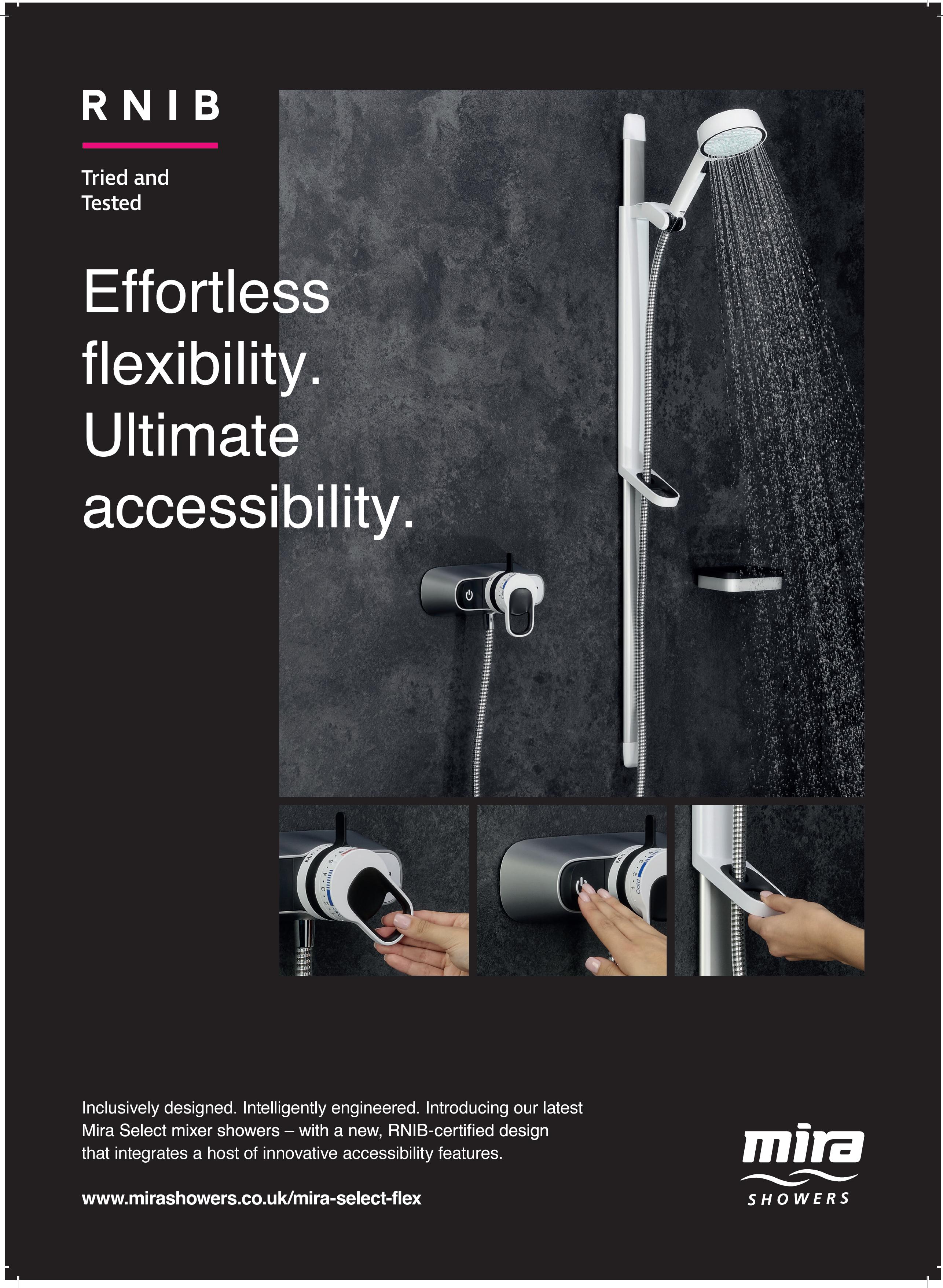
KITCHENS, BATHROOMS & DISABILITy NEEDS ROUND-UP
EcoVadis Silver Medal for sustainability achievement

AKW, a leading provider of bathrooms, kitchens and mobility aids, is now recognised for being in the top 15% of businesses who have participated in the EcoVadis assessment The silver medal accreditation reflects the company ’ s dedication to incorporating environmentally and socially responsible practices into its operations, and assures customers that they are sourcing products from a sustainable supplier
EcoVadis, the world’s largest provider of business sustainability ratings, helps companies gain greater insight into their sustainability performance The medals are awarded based on 21 major sustainability issues and are reviewed annually Working collaboratively with the EcoVadis project team, all AKW departments are actively developing comprehensive improvement programmes, centred on driving continuous advancements in sustainability practices
n For more information visit www.rdr.link/laq014
ESG report highlights water-saving products
Bristan’s new Environmental, Social Responsibility and Governance (ESG) report outlines the organisation’s commitment to sustainability and shines a spotlight on its water-saving products including its new Eco Start technology

The company recently introduced its Eco Start technology on bathroom taps, which saves energy by having cold water as the default central start position of the tap handle This means that hot water is only activated when the tap lever is moved from the central position, so your boiler is not unnecessarily fired up Also featured are pre-fitted flow limiters, infrared taps that automatically turn off when not in use, and BREEAM-certified self-closing ‘push button’ taps
n Bristan Group’s ESG report is available here www rdr link/laq015

n More information on Bristan’s water-saving products here www.rdr.link/laq016
New dMEV-NICO fan for new-build homes
Domus Ventilation has launched a new Decentralised Mechanical Extract Ventilation (dMEV) fan, dMEV-NICO, to provide continuous background extract ventilation for new-build properties

Designed to remove waste and moist air from a single wet room, such as bathrooms and kitchens, dMEV fans continuously extract the waste air at both low trickle or boost speeds which, in the case of the new dMEV-NICO, is automatic thanks to a built in monitoring device which detects occupants’ operation The fan provides a cost-effective extract solution that has been built to achieve the ventilation rates as set out in the latest edition of Part F and L of the Building Regulations It is suitable for wall, ceiling and window mounting The product comes with wall and in-room installation kits, including ducting and grilles
n More information on the dMEV-NICO fan can be found here www.rdr.link/laq017
Surge in demand for the Terrain FUZE Stax drainage system
The range of two-part prefabricated stack configurations, designed to make installing the most common low to highrise applications simpler and quicker, has proved so successful that Polypipe Building Services’ team are working flat out to meet demand Terrain FUZE Stax helps reduce installation times because typically large-scale drainage stack projects involve repeating similar configurations of loose components across floors This means significant time is spent on repetitive cutting and welding jobs The Stax range removes a lot of this time-consuming work by offering prefabricated products in the most common configurations covering kitchens, bathrooms, and utility rooms Within these are a broad range of options including different top and bottom sections, stack diameters, vents and more to ensure maximum flexibility in meeting on site demands
n More information about FUZE Stax here www rdr link/laq018


New vertical platform lifts range
Stannah’s new platform lifts range is specifically developed for public buildings, housing, leisure, hospitals and schools, and offers more cabin sizes, options, finishes and accessories In addition, the range is offered with 'open protocol' parts, so any lift maintenance company can maintain the lift Alternatively, Stannah can provide a planned maintenance package
Stannah Midilift CL is an energy-efficient cabin platform lift that is said to be simple to install and with a small footprint It is a compact-sized hydraulic lift with a hinged landing door in a choice of panoramic or vision panel doors Whilst the Midilift CLS is a hydraulic cabin platform lift with automatic sliding doors and the appearance of a conventional passenger lift with energy-efficient performance and space-saving design

n All the new platform lifts are live on the Stannah lifts website www.rdr.link/laq019

2 8 I L A B M M A R C H / A P R I L 2 0 2 4

Addressing ‘hard to treat’ social housing
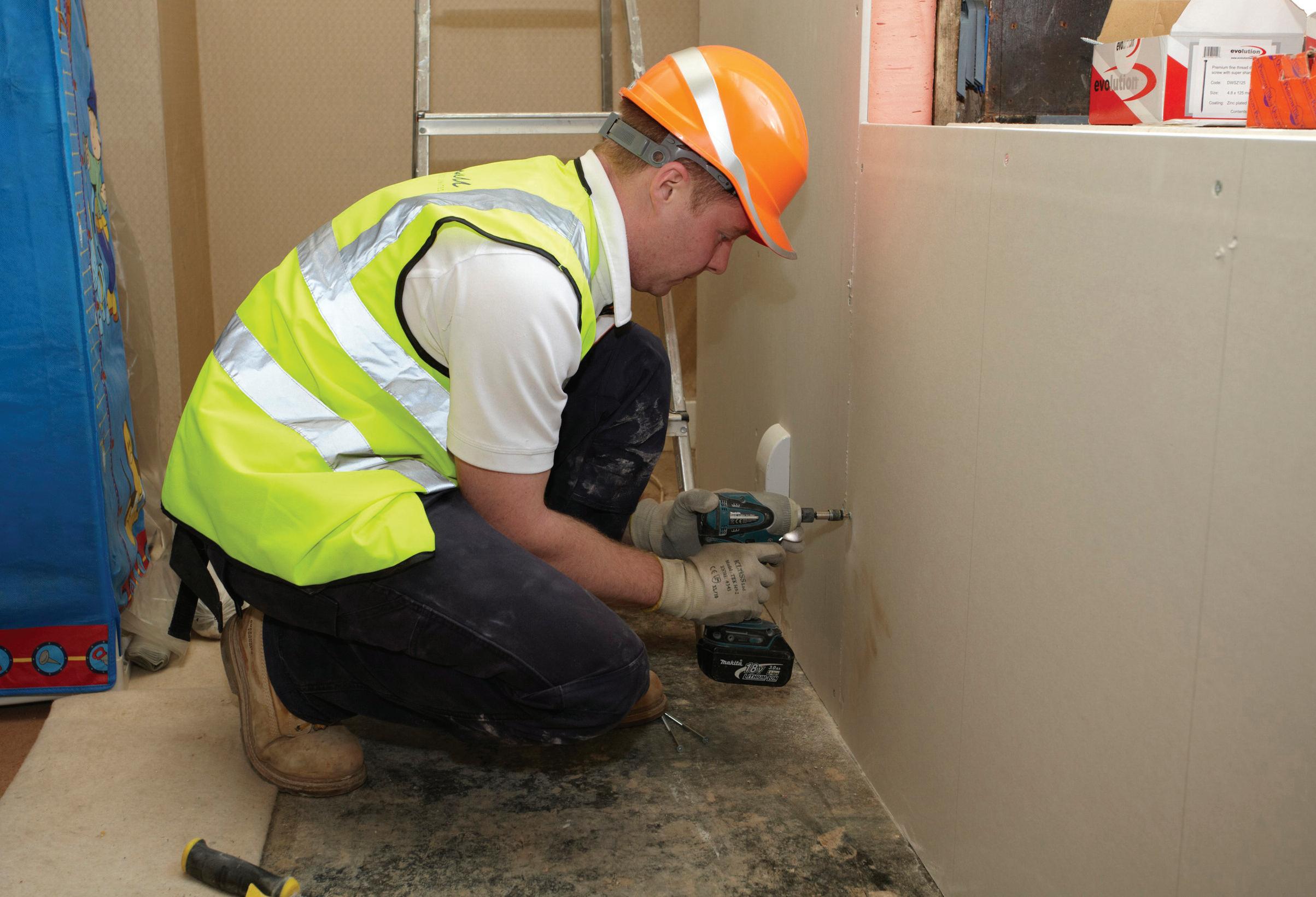

Jonathan Ducker, Head of Regulatory Affairs at Kingspan Insulation, considers how social housing providers can insulate residents living in ‘hard to treat’ properties from fuel poverty, by ensuring existing homes retain heat effectively, and offers advice on installing inter nal wall insulation.
The latest annual fuel poverty statistics report show that the average fuel poverty gap increased by 66% in real terms between 2020 and 2023 due to rising energy costs1 For social housing providers, a key step to protecting occupants against this is by ensuring existing stock retains heat effectively Whilst substantial progress has been made retrofitting loft and cavity wall insulation, recent data shows that just 26% of solid walled social housing properties feature wall insulation2 These untreated properties tend to be the oldest and least energy-efficient, leaving occupants at significant risk of fuel poverty
The simplest approach to addressing these so called ‘hard to treat’ properties is by fitting external wall insulation (EWI) systems which wrap around the existing building However, EWI solutions will not always be feasible, meaning the only option is to fit internal wall insulation (IWI) When designed and installed correctly, IWI
solutions can significantly reduce heat losses and support lower heating bills To avoid unintended consequences, however, it is essential that this work is carried out with careful planning and consideration for the building and its context
Moisture open or closed
Before fitting any internal wall insulation, it is essential to fully understand the moisture properties of the existing building and walls Many solid walled properties constructed prior to the 1920s feature permeable wall constructions that allow moisture to slowly pass through them; however not all walls are permeable, or have become much less so, since original construction In an uninsulated property, heat from inside the property and from the sun helps to dry the wall
Once insulation is fitted however, the heat loss from the inside will be greatly reduced, interrupting the drying process and potentially allowing vapour within the
construction to condense interstitially (between layers) An appropriate condensation risk assessment can determine this risk and the walls capacity to handle any condensation that might form
There are two ways to address vapour in a wall construction The first of these is using a ‘ vapour open ’ system with permeable materials that can, to a point, buffer moisture The drawback is that buffering capacity is limited beyond a certain point, which means that walls will typically need to be insulated to a lower level than might otherwise be preferred
The alternative is a ‘ vapour closed’ solution, using moisture closed materials, such as phenolic insulated plasterboard This approach relies on the wall construction being (or becoming) suitably resistant to the level of driving rain present and requires a vapour control layer (VCL) to be installed to prevent or reduce, to a safe level, the interstitial condensation that might occur within the improved wall construction
M A R C H / A P R I L 2 0 2 4 L A B M I 2 9 ROOFING, CLADDING & INSULATION
Kingspan Kooltherm K118
Insulated Plasterboard features an integral VCL and has a thermal conductivity of just 0.019W/mK
ROOFING, CLADDING & INSULATION
“PAS 2035 sets out a clear process for assessing existing proper ties and developing an improvement plan, w hich is sensitive to their par ticular design and circumstances this is known as a Whole House Approach ”
Phenolic boards are typically more thermally-efficient than moisture open alternatives, meaning it is possible to effectively insulate walls with a slimmer thickness maintaining internal space When fitting these boards, all junctions must be carefully designed and installed to ensure both VCL and insulation run continuously across walls and junctions
Which approach is appropriate for a building depends on the project specifics, its use, location, construction, condition, significance, ventilation, moisture load and level of heating; which is why a proper assessment and development of a plan for improvement is so important

Alongside the choice of insulation, there are a number of other factors that need to be carefully considered before carrying out IWI
Whole House Approach
PAS 2035 sets out a clear process for assessing existing properties and developing an improvement plan, which is sensitive to their particular design and circumstances this is known as a Whole House Approach This improvement plan is clearly and logically phased and works must be carried out by contractors certified to PAS 2030:2023 a supporting installer standard for energy retrofits The works and supporting documentation are logged in a Property Hub, which social housing providers can access providing a golden thread of information There is also a clear post-handover evaluation process to ensure measures are performing effectively and, where necessary, to address any issues
Where IWI solutions are considered as part of the plan, a number of assessments will be carried out including:
l A full survey of the building characteristics and condition (any issues must be addressed prior to improvement work commencing)
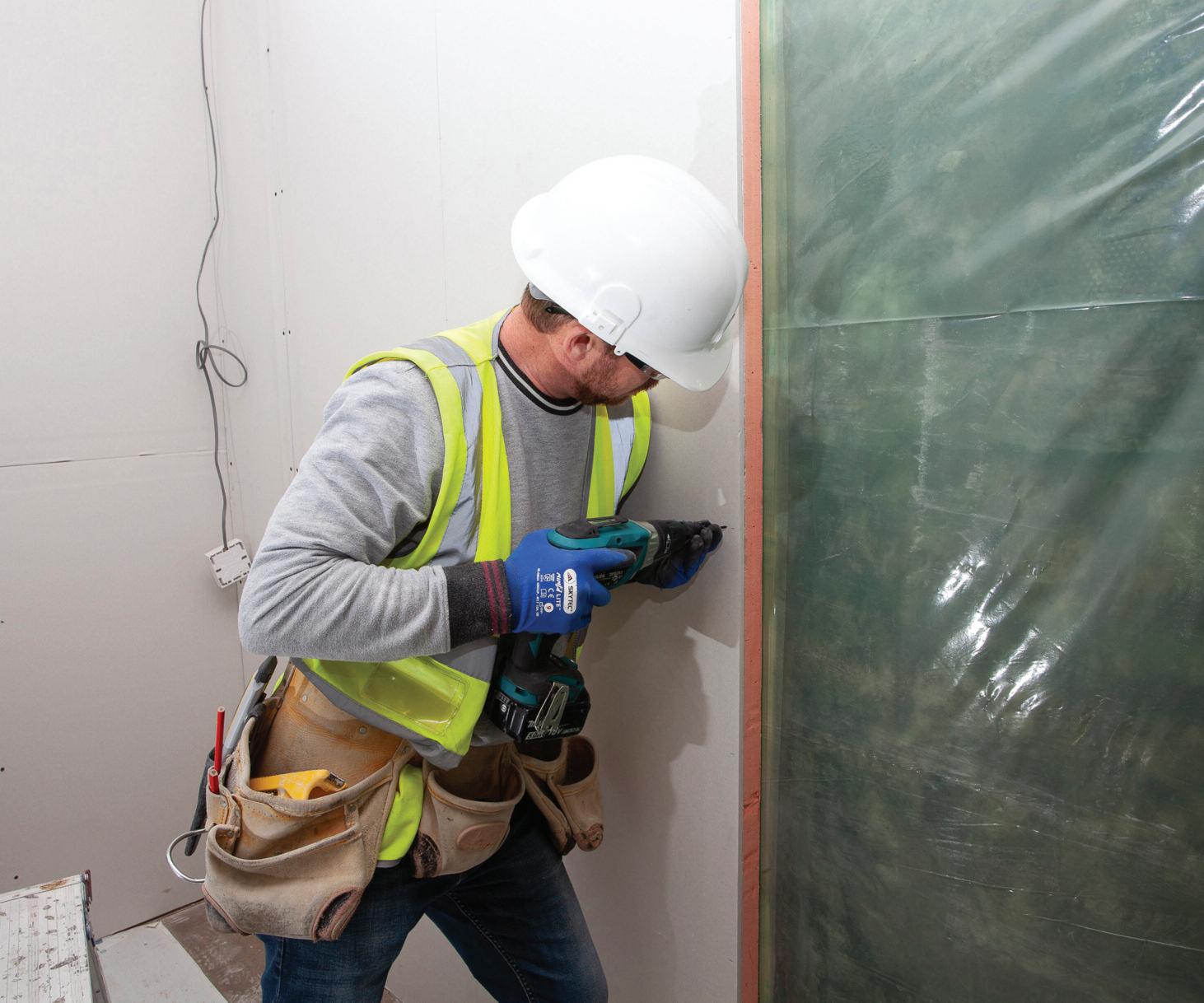
l A moisture risk assessment to BS 5250:2021 and driving rain risk assessment
l An assessment of internal ventilation (IWI solutions can significantly reduce air-leakage from a property)
l Insulation details that consider interaction with other elements and adjoining properties (this may recommend the installation of additional insulation in the floor, roof or on party walls)
By adopting this Whole House Approach, it should be possible to identify the most suitable IWI solution for the property and deliver a retrofit that provides the energy savings expected without unintended consequences
Long-term plan
Research has shown that retrofit work is expected to represent over 90% of the required building emissions reductions in the UK for us to meet our net zero emissions goal3 Addressing so called “hard to treat” solid walled properties is a key step in this process and is also essential to safeguard occupants from fuel poverty By adopting the PAS 2035 framework, social housing providers can ensure that where IWI solutions are required, they are properly designed and installed with clear consideration for the existing building
1 Annual fuel poverty statistics report 2024, Department for Energy Security & Net Zero
https://www gov uk/government/collections/fuelpoverty-statistics#2023-statistics
2 English Housing Survey 2022 to 2023, Department for Levelling Up, Housing & Communities
https://www gov uk/government/statistics/chaptersfor-english-housing-survey-2022-to-2023-headlinereport/chapter-5-energy-efficiency
3 Global retrofit Index, Kingspan:
https://www kingspangroup com/en/sustainability /product-sustainability/global-retrofit-index/

3 0 I L A B M M A R C H / A P R I L 2 0 2 4
n For more information on Kingspan Insulation’s internal wall insulation solutions visit www rdr link/laq020
moisture
to ensure a continuous VCL and insulation
Careful
detailing at junctions and around openings is essential when fitting
closed IWI






Leading role for EWI
External wall insulation systems are at the forefront of Modern Methods of Construction and given more than a third of the heat in a building is lost through its walls, high quality EWI, also known as ETICS (External Thermal Insulation Composite Systems), are a must for any energy-conscious building projects or retrofit schemes
The demand to accelerate the UK’s transition to net zero comes as a cost-ofliving crisis deepens, with the energy efficiency of homes being a huge conversation Retrofitting properties to reduce energy bills has become a huge talking point recently, particularly for the most deprived areas of society, as energy prices soar
E W I s y s t e m s a r e a k e y m e a s u r e i n i m p r o v i n g e x i s t i n g h o u s i n g s t o c k t o a c h i e v e m o r e e f f i c i e n t t h e r m a l v a l u e s a n d r e d u c e b o t h h e a t l o s s a n d e n e r g y c o s t s U s i n g i n s u l a n t s s u c h a s E x p a n d e d Po l y s t y r e n e o r M i n e r a l Wo o l , E W I c a n m a k e a r e m a
Improving thermal values and reducing energy bills can be combined with a wide range of aesthetic finishes,
which ensure regenerated housing stock and estates can achieve an improved quality of life for the householders
Fabric first retrofit relevancy
EWI is a pivotal cladding material to consider in the retrofit landscape for social housing stock owned by local authorities and housing associations External wall insulation measures help to reduce carbon and greenhouse gases across local authority areas spanning the UK When
combined, the impact and combined Uvalue data from across these local authority areas is helping to positively contribute to the UK’s overarching Net Zero Carbon goals
It is for this prime reason that EWI is regarded as one of the most effective ways to thermally upgrade existing buildings and why it is ideal for local authorities and housing associations with ageing social housing stock, often dating back to the 1940s, 50s and 60s


r k a b l e c o n t r i b u t i o n t o r e t r o f i t i n i t i a t i v e s a n d t o t h e N e t Z e r o C a r b o n a g e n d a
M A R C H / A P R I L 2 0 2 4 L A B M I 3 3 ROOFING, CLADDING & INSULATION
Ben Edmondson, Technical Director at façades specialist Aliva UK, comments on exter nal wall insulation’s pivotal role in the UK retrofit agenda
installed on
Avenue low-rise housing
EWI solution
the Ennismore
scheme
tower block featuring EWI and brick slip EWI solution installed on College Croft high-rise
Wade
House high-rise
“EWI is a pivotal cladding mater ial to consider in the retrofit landsca pe for social housing stock owned by local author ities and housing associations . ”
Qualifying as a fabric first solution, this seeds the cladding solution’s grant funding relevancy under the Social Housing Decarbonisation Fund (SHDF), Great British Insulation Scheme (GBIS) and the fourth phase of the Energy Company Obligation ECO4
Fabric first results fast
Alongside qualifying as a fabric first solution, and the inherent benefits this brings to retrofitting in itself, EWI systems deliver immediate results when compared to energy efficiency measures like solar photovoltaic panels or ground source heat pumps, which take time to aggregate/yield their results, benefits and savings
EWI instead brings immediate advantages improved thermal values are experienced straight from installation, which is swiftly followed by reductions in residents’ energy bills due to lower energy consumption required EWI also generates improved U-values, which equals energy saving for the planet It’s more relevant than ever as a retrofit solution for stock
owning local authorities and housing associations to enhance their homes, to the benefit of residents, as it helps save money on fuel costs in the current cost-ofliving crisis
Certification and standards
Quality, standards, longevity and reliability of EWI systems are pivotal for the public sector’s procurement landscape and reassurance on the safety of products Aliva UK’s Termok8 EWI systems, for example, are fully tested and certified for retrofit applications under BBA Certificate 11/4841
This BBA certification is relevant for masonry, concrete, blockwork and no-fines concrete substrates, which is ideal for the many solid wall houses, masonry and concrete properties and high-rise properties owned by local authorities and
Registered Providers
Aliva’s EWI Termok8 ranges hold fire performances to Euro Class EN 13501-1 of A1, A2,s1,d0 and B and its coloured textures have also been awarded the Fraunhofer Institut fur Bauphysik certification for algae and fungal resistant coatings As an EWI specialist and system designer, Aliva is also a member of the recognised External Wall Insulation trade body The Insulated Render and Cladding Association (INCA) has a 40year history and a membership structure that represents contractors, system designers and associates INCA membership is a marker of reputable EWI specialists with recognised standards of competence



Although neutral colours are most common, Aliva has a range of over 400 colours spanning its Termok8 standard palette and its STRONG and REFLECT range, these include vibrant colours from pillar box red, to darker shades with solar reflective properties Aliva can also offer fully certified clay and lightweight slip finishes, which can be used in isolation or combined with the textured finishes to create a traditional looking building façade
Versatility of insulants
EWI is incredibly versatile, insulants come in a range of thicknesses to deliver energy-efficient results for a specific project’s thermal requirements or can be used to create a particular design intent
Optimising a nationwide retrofit programme
The UK has some of the oldest housing stock in Europe, it’s estimated that some 37 8% of the UK’s houses were built before 1945 As INCA highlights as part of its 2024 call to government, to optimise the delivery of an effective nationwide retrofit programme to improve these 10+million homes, there needs to be a prioritisation of the fabric first approach EWI delivers the greatest cost saving impact on fuel bills of all energy efficiency measures as well as delivering significant health benefits to tenants and residents

3 4 I L A B M M A R C H / A P R I L 2 0 2 4
Minerale
D Clay Slip
Termok8
Modular
n For more information on Aliva UK’s EWI range visit www.rdr.link/laq021 ROOFING, CLADDING
INSULATION
&
Wythenshawe high-rise tower block featuring block EWI and brick slip





Across a wide range of proven renewable technology solutions, to technical specifications and training support, Marley is working with local authorities to help deliver energy-efficient, sustainable social housing, which also reduces energy cost pressures for tenants. Here, Chris Marshall, Area Sales Manager at Marley outlines the benefits of a collaborative, single source strategy approach as the sector embarks on major retrofit and upgrade programmes.
The impact of the Social Housing Decarbonisation Fund (SHDF) has better enabled local authorities and housing providers to access funding for sustainable housing improvements, enhancing energy efficiency With the recent release of the second wave of funding, an extra £80m supplements the initial £800m allocation aiming to create warmer, more efficient homes and alleviate tenants' energy cost pressures Yet against this backdrop, the proper system specifications are crucial for longterm success in meeting tenants' needs
The solar PV momentum
The growth of solar PV installations on UK rooftops is going from strength to strength Government statistics from 2023 show that solar installations1 stand at over 1 35 million, with the period between 2022 and 2023 seeing the largest annual installation increase for seven years
The escalating popularity of solar PV is down to several factors, including a reduction in the cost of solar PV systems over the past decade From a regulatory perspective, solar PV on the roofscape,
combined with an efficient gas boiler, is also the quickest and most cost-effective way for local authorities to meet the 31% carbon reduction targets introduced within Part L Building Regulations Alongside retrofit projects to improve the energy efficiency performance of existing social housing stock, the inclusion of solar PV when designing new social housing developments should be a central consideration
The latest integrated PV roof systems such as Marley’s SolarTile offer a more visually appealing, cost-effective and easier to install option Replacing a section of roof tiles, integrated solutions provide a sleek aesthetic and function as a seamless part of the overall roof aesthetic
A wider renewable package
Local authorities are urged to take a holistic view when it comes to selecting the range of renewable technology solutions that will bring homes to an EPC C standard The combination of solar PV on roofscapes, coupled with battery storage that can retain energy generated from a clean source, alongside installed EV charging that can use solar power
“...opting for a single source strategy ena bles local author ities and housing associations to effectively use availa ble budgets and funding from the Social Housing Decarbonisation Fund allocation.”
generation to provide low-cost motoring, makes a compelling argument that can underpin sustainability objectives
To further drive enhanced procurement efficiencies, opting for a single source strategy enables local authorities and housing associations to effectively use available budgets and funding from the Social Housing Decarbonisation Fund allocation
Understanding the growing importance of renewable system solutions, Marley has built a wider renewable system, as well as technical support and training, which local

CLADDING & INSULATION
ROOFING,
Denbighshire Council properties with Marley’s solar PV installed on the roofs

authorities across the UK are already taking advantage of The full marley renewable system offer already includes solar pV and EV charging and has been further strengthened with the introduction of easy to install battery storage and inverter solutions They allow tenants to store the energy generated via solar pV on the roof, so they become less reliant on the grid as demand for renewable answers escalates, local authority specifiers can now collaborate with partners such as marley to devise a comprehensive renewables package to drive the improvements that will increase energy efficiency, while helping tenants reduce energy costs
Specification and training support
aside from product selection, marley is also supporting the sector in additional ways an experienced technical team is on hand to guide and inform local authority specification decisions that can make a positive contribution to the all-important Epc ratings The service will identify the best roof location for the solar pV system, design the most effective solar array and create detailed calculations that will ensure the roof installation delivers the desired power generation and for local authorities keen to ensure that the installation of new renewable technologies is always right first time, every time, marley’s extensive training support for in-house installer teams can be another value-added component as part of a wide-ranging, results-orientated collaboration The company provides weekly one-day solar installation training courses offering a comprehensive overview of how solar pV works, how to set out a system and tips to consider when dealing with a complex array system
in addition, marley’s Sustainability and Solar pV: pitched roofing specification cpd aims to drive a better understanding of the role played by solar The cpd’s content provides local authority specifiers with a detailed overview of all aspects of solar pV; what to know and what to avoid This includes how solar pV interacts with the rest of the designed roofing system and the compliance and sustainability advantages it delivers 1 www solarpowerportal co uk/government figures

n For more details on Marley’s training support for solar PV installations, visit www rdr link/laq022
rOOfinG, claddinG & inSUlaTiOn rOUnd-Up

New insulation product provides solution to damp and mould arc Building

Solutions has unveiled the retrofit Eaves insulator, which provides an effective solution to the perennial challenge of heat loss at the eaves junction its design delivers essential insulation up to the wall plate, significantly reducing heat loss and thermal bridging whilst also maintaining the vital 25,000mm2 ventilation area required to prevent moisture build up The prevalence of warmer internal walls, combined with appropriate ventilation in turn, reduces condensation and the risk of damp and mould formation, enhancing thermal performance made from noncombustible glass mineral wool, it is ideal for any existing property with a pitched roof/eaves space and ventilation at the soffit or eaves where access to the wall cavity is restricted its wedge-shape ensures full insulation of the required space in any ventilation scenario whilst its patented hinge design renders it suitable for all roof pitches
n More information on the Retrofit Eaves Insulator here www.rdr.link/laq023
Preventing anchor marks on EWI
an innovative anchoring solution from EJOT helps to optimise the aesthetics of externally insulated walls by preventing nuisance anchor marks forming on the rendered finish

The ejotherm STr U 2G is the latest generation of the company ’ s universal anchor washer it enables the countersunk installation of EWi (external wall insulation) systems or ETicS (external thermal insulation composite systems) covered with a cap The solution prevents the formation of anchor marks because it allows for consistency in the layer of insulation The combination of the special ETicS anchor design and matching insulating material caps means anchor marks can be avoided in the long-term and unsightly spots can become a thing of the past Easy to use, it comes with a special installation tool, which allows the anchors to be installed in a recessed manner and sunk into the insulation material in a controlled way
n Find out more about the EJOT STR solution at www rdr link/laq024
Marley’s SolarTile is an integrated PV roof system
m a r c h / a p r i l 2 0 2 4 l a B m i 3 7
Whether it’s high-rise residential, schools, hospitals or prisons, there is real momentum to turn MMC into BAU



Escaping the ghosts of the past: the rise of the UK’s of fsite sector
Offsite construction in the UK is so much more than post-war prefab and struggling MMC housebuilders But the sector’s many successes struggle to get their story told. Adam Salt, Business Development Manager for A. Proctor Group, looks at the bigger picture and explains why it’s important to make sure the positives don’t get forgotten when we think about modular and offsite.
The offsite sector has undoubtedly faced issues recently specifically in the housing sector, with a number of high-profile manufacturers ceasing operations in 2023 Specific factors played their part in each individual case, though it’s possible to draw some broad conclusions
Delivering traditional housing developments using modern methods of construction (MMC) required organisations to plan for, and finance, a scale of production that isn’t yet there Those financial risks were compounded by delays in purchasing land and securing planning permissions
Yet the speed and quality made possible by MMC is demonstrated every day in the delivery of other buildings Whether it’s high-rise residential, schools, hospitals, warehouses or prisons, there is real momentum to turn MMC into BAU (business as usual)
UK construction is setting an example that others want to follow My colleagues and I talk to people all over the world about modular and offsite
construction methods Those conversations have made one thing particularly clear: the UK is pretty good at this!
Some construction companies in the United States, for example, are just grasping the potential They see the UK almost like pioneers, but that picture isn’t necessarily reflected here at home When failures in MMC-delivered housing are reported in the wider media, they link modern housing to the flawed prefab and non-traditional housing of yesteryear Rather than being elevated by success stories, the sector is instead weighed down by continual comparisons to past failures
Encouraging positive change from the top down
Arguably the biggest success story is that the wider construction industry has collaborated with the UK Government to try and affect positive change And perhaps the most significant result of that collaboration is the Construction Playbook, published at the end of 2020
The playbook sets how government will work with industry to deliver public projects more efficiently, with a particular focus on

getting projects and programmes “right from the start” Not only is this a positive in itself, but, changes and improvements evidenced in public procurement usually start to become the norm throughout construction
Promoting the adoption of construction platforms
A key goal of the Construction Playbook is to procure more projects using construction platforms These are “standardised and interoperable components and assemblies”, where manufacturers can offer a ‘kit of parts’ for use with a common structural solution

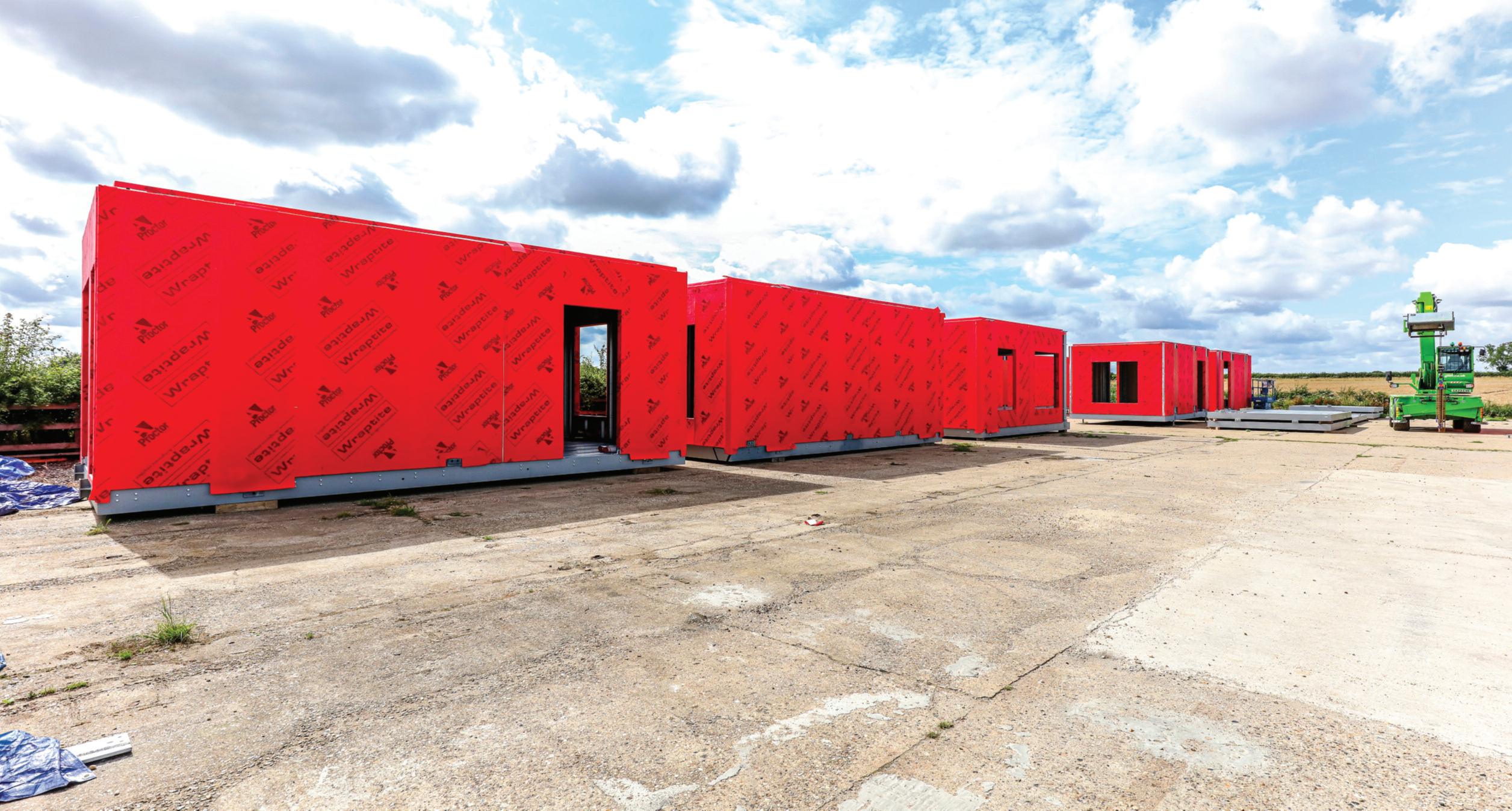
MODULAR & OFFSITE CONSTRUCTION


As shorthand, platform construction is often compared to the modern automotive assembly techniques used on car production lines One of the earliest examples of a fully realised construction platform is Seismic We supplied our Wraptite external air barrier system to the Northampton School for Boys MultiAcademy Trust, which was a Department for Education-funded project that used Seismic’s technology
A key advantage of Seismic, and platforms generally, is the speed and efficiency with which buildings can be ‘assembled’ (rather than ‘constructed’) thanks to the repeatability offered by the system design
Products specified for use with such systems need to work within that environment, rather than risk slowing things down The self-adhered nature of the Wraptite membrane did just that, providing vapour permeability and airtightness in a single layer It saved on labour and material costs, and contributed to the building’s performance requirements
Supporting panelised and volumetric offsite solutions
Product platforms represent an exciting future for the construction industry, and are backed by government procurement guidance Of course, modular solutions like panels and volumetric systems remain an important part of the landscape Indeed, they are often still the first thing people think of when talking about

“One of the ear liest examples of a fully realised constr uction platfor m is Seismic. We supplied our Wra ptite exter nal air barr ier system to the Nor thampton School for Boys Multi-Academy Tr ust, which was a Depar tment for
Education-funded project that used Seismic’s technology.”
modular, offsite or MMC While the offsite/modular sector is delivering exciting schemes across the country, it is still grappling with two particular challenges: storage and transport
When panels are completed in the factory, they are typically shrink-wrapped The materials used to make the panel naturally contain moisture, but rather than being able to dry out during storage, the wrapping traps moisture within the system
Here again, Wraptite offers a significant benefit Its vapour permeability allows moisture out of the construction, helping the panel to dry out And the self-adhered nature of Wraptite protects finished products during transportation too
The majority of membrane solutions are taped, meaning they are not fully bonded to the substrate During transport, lateral air movement across the surface pulls at the membrane, tearing it and potentially damaging the panel That doesn’t happen when Wraptite is used
Working with the offsite sector to offer bespoke solutions
These are all important features of a single product in the A Proctor Group
range, and they can be taken advantage of by any project using offsite or modular solutions Where we really work best, however, is engaging with project teams to find the best product, or combination of products, to deliver a building’s performance goals
This approach mimics how we also work with individual offsite and modular manufacturers to find ways in which we can help to improve their processes
Collaboratively, we look at the manufacturing, storage and transport stages to find the right solution for any given system This collaboration at both manufacturer and project level is what gives us such optimism in the offsite sector, because we ’ re seeing positive outcomes every day Our Wraptite membrane might be the right solution for you, but it is not our only solution
n For more information about

A. Proctor Group’s membranes for offsite and MMC, and to find out how the company can work with you to offer the right membrane for your project, please visit www.rdr.link/laq025
M A R C H / A P R I L 2 0 2 4 L A B M I 3 9
Wraptite’s vapour permeability allows moisture out of the construction, helping the panel to dry out


Phil Pavey, Managing Director at Algeco offsite, explores the benefits presented by offsite construction and an innovative modular platform design system for secondary schools, like the recently finished Laurence Calvert Academy in Leeds
The demand for secondary school places is increasing, with an estimated 42,000 places needed by 2026/7 to address this growing demand According to Government data, by September 2024, over 223% of state-funded secondary schools are operating at or above capacity, posing a risk to more than 120,000 young individuals in securing school places
To address these ongoing challenges, efforts are being made to expand existing secondary schools or build entirely new, larger schools using modular construction This forward-thinking approach, favouring modular construction, not only proves to be cost-effective but also minimises disruptions to learning
Utilising offsite construction provides a quicker and less disruptive option compared to conventional building methods Modern modular solutions can deliver a high Pre-Manufactured Value (PMV) of approximately 80%, allowing construction timelines to be halved
Laurence Calvert Academy sets the benchmark
Laurence Calvert Academy in Leeds was designed by DLA Architecture to accommodate 1,050 students across years 7 to 11 The Department for
Education (Df E) project was offered through the Mod-C Secondary School Framework The academy was named in honour of Sergeant Laurence Calvert, a former student who received a Victoria Cross in 1918

MODULAR & OFFSITE CONSTRUCTION
Laurence Calvert Academy
l
scope of work included the construction of a three-storey school block supplying 192 modules and a hybrid steel frame build for the sports hall
I n n o v a t i v e d e s i g n p
a t f o r m s The

We a p p r o a c h e d t h i s £ 1 9 2 m p r o j e c t u s i n g D e s i g n f o r M a n u f a c t u r i n g a n d A s s e m b l y ( D f M A ) , w h i c h h e l p e d u s t o m a k e t h e 1 9 2 m o d u l e s 5 0 % f a s t e r a n d a c h i e v i n g a n i m p r e s s i v e 2 5 % r e d u c t i o n i n C O 2 e m i s s i o n s ( o r 2 5 1 t / C O 2 s a v i n g ) c o m p a r e d t o c o n v e n t i o n a l m o d u l a r s y s t e m s T h a t ’ s t h e e q u i v a l e n t o f 1 2 5 f l i g h t s f r o m Lo n d o n t o S y d n e y ! T h e s c o p e o f w o r k a t La u r e n c e C a l v e r t A c a d e m y i n v o l v e d c o n s t r u c t i n g a t h r e e - s t o r e y w h o l e s c h o o l b l o c k s u p p l y i n g 1 9 2 m o d u l e s , a l o n g w i t h a h y b r i d s t e e l f r a m e b u i l d f o r t h e s p o r t s h a l l , a n d a s s o c i a t e d e x t e r n a l w o r k s T h e l a r g e - s p a n s p o r t s h a l l , d e s i g n e d w i t h a h y b r i d s t e e l f r a m e s y s t e m , s e r v e s a s a f l e x i b l e a n d m u l t i - p u r p o s e s p a c e f o r v a r i o u s a c t i v i t i e s T h e h y b r i d s t e e l f r a m e s y s t e m i s b e i n g u s e d f o r t h e s p o r t s h a l l t o a l l o w f o r i n c r e a s e d c e i l i n g h e i g h t s a n d t h e i n c o r p o r a t i o n o f l a r g e o p e n a t r i u m s A d d i t i o n a l l y, i t s e a m l e s s l y i n t e g r a t e s w i t h o u r m o d u l e s , o f f e r i n g e n h a n c e d f l e x i b i l i t y, v e r s a t i l i t y a n d g r e a t e r d e s i g n s c o p e
Other facilities within the overall design include classroom provision, office accommodation, group rooms, storage, meeting room, ICT suite, main hall, kitchen, welfare facilities, car parking and pupil drop-off area During construction, students were being taught in a temporary facility
Construction of the entire new school was completed in September of 2023, ready for the new term The academy has rightfully earned its reputation as the best new school in Leeds after taking just 52 weeks to complete
Lower carbon impact
By utilising the innovative construction design platform, we were able to meet strict construction programmes and complete the academy much faster than a conventional modular build As this innovative platform is designed with the Government’s Construction 2025 strategy in mind, it offers significantly lower carbon impact and much better value than traditional construction
Constructed to rigorous energyefficient and sustainable standards, this academy achieved a 'very good' BREEAM rating This means it is within

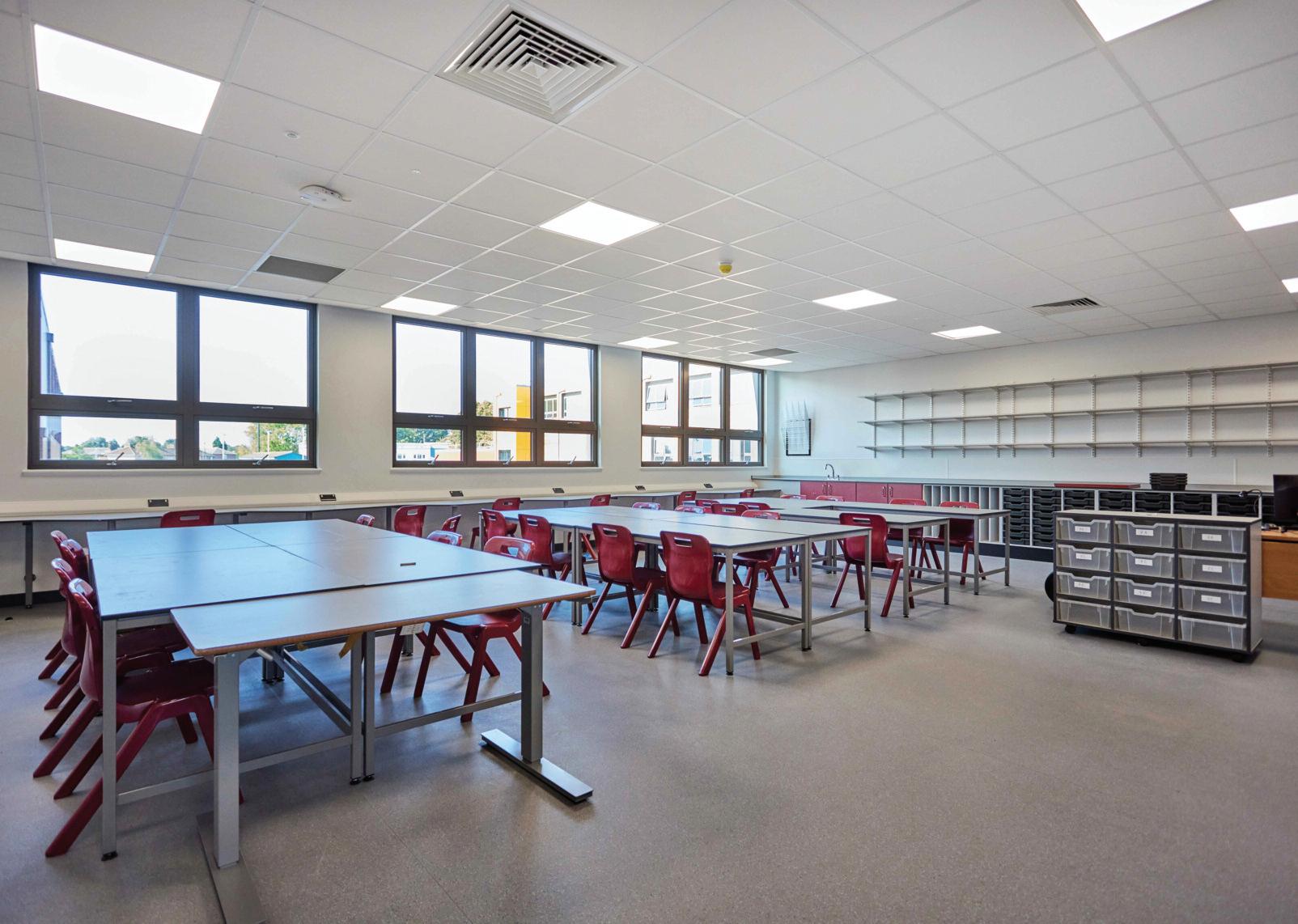
the top 25% of buildings in terms of sustainability The modular and offsite construction system used at Laurence Calvert Academy is fully compliant with Building Regulations, featuring passive ventilation and boasting a minimum design life of 60 years
Before securing the contract to construct the new Laurence Calvert Academy, we were required to showcase a comprehensive Waste Management Plan and be registered with the Considerate Construction Scheme We also had to align with the ‘Leeds Talent and Skills Plan’ by employing local trades by improving local employment opportunities and, where possible, minimising the effects of extended travel
Next generation modular school builds
The new design platform design delivers significant benefits in various areas It leads to a notable reduction in both operational and embodied carbon, achieved through factors such as enhanced design efficiency, materials selection and improved manufacturing effectiveness, leading to minimised wastage
Moreover, this design platform, collaboratively developed by the modular industry and BRE, brings significant environmental benefits with the modules at Laurence Calvert achieving 581 3 kgCO 2e per m2, well below Construction 2025’s target of 1,300 kgCO2e per
“We a pproached this £19 2m project using Design for Manufactur ing and Assembly (DfMA), w hich helped us to make the 192 modules 50% faster and achieving an impressive 25% reduction in CO2 emissions (or 251t/CO2 saving) compared to conventional modular systems ”
a d d r e s s t h e s h o r t a g e o f s c h o o l p l a c e s , a n d t h e m o d u l a r i n d u s t r y i s c o l l a b o r a t i n g t o o f f e r a v i a b l e s o l u t i o n t h r o u g h p a r t n e r s h i p s a c r o s s t h e s e c t o r T h e s e e f f o r t s h a v e a l r e a d y d e l i v e r e d r e s u l t s w i t h t h e d e v e l o p m e n t o f t h e p l a t f o r m d e s i g n , w h i c h w a s d o n e t h r o u g h a n i n d u s t r y - w i d e c o n s o r t i u m
Ultimately, this collaborative approach is exactly what is needed to increase school places quickly Modular construction therefore has the ability to alleviate pressure on school place shortages, but also to pave the way for innovative and sustainable modular construction practices in the future
n Discover more about permanent modular buildings for education here www rdr link/laq026

n To learn more about Algeco, visit www.rdr.link/laq027
m2 T h e g r o w i n g d e m a n d f o r e f f i c i e n t , f a s t e r, a n d h i g h e r - q u a l i t y c o n s t r u c t i o n s o l u t i o n s t o a d d r e s s c a p a c i t y r e q u i r e m e n t s i n t h e e d u c a t i o n s e c t o r C o l l a b o r a t i v e e f f o r t s h a v e b e e n m a d e t o
M A R C H / A P R I L 2 0 2 4 L A B M I 4 1
The new school was completed in September 2023
BUILDOFFSITE announces Offsite Expo collaboration
O f f s i t e c o n s t r u c t i o n m e m b e r s h i p b o d y B U I L D O F F S I T E ( B O S )
w i l l b e p a r t n e r i n g w i t h O f f s i t e E x p o f o r t h i s y e a r ' s e v e n t C e l e b r a t i n g i t s 2 0 t h a n n i v e r s a r y t h i s y e a r , B O S i s c o n t i n u i n g t o b e t h e p r i n c i p a l a n d t r u s t e d v o i c e o f t h e i n d u s t r y i n t h e w o r l d o f o f f s i t e c o n s t r u c t i o n a n d h a s m e m b e r s b a s e d i n t h e U K , a s w e l l a s i n E u r o p e , A s i a a n d N o r t h A m e r i c a B u i l d i n g o n t h e s e i n t e r n a t i o n a l c o n n e c t i o n s , B O S w i l l c o - h o s t t h e O f f s i t e S u m m i t a t t h e e v e n t , f o c u s i n g o n i n t e r n a t i o n a l b e s t p r a c t i c e o n d a y o n e a n d s h o w c a s i n g t h e i r o w n a c t i v i t i e s o n d a y t w o
Dirk Vennix, Executive Director of BUILDOFFSITE, says: "This expo has regularly exhibited the best of the offsite construction industry, so to be able to highlight the international expertise of BOS members and other key stakeholders is very exciting ”
As well as the collaboration with BOS, this year's event will also feature networking opportunities, with nearly 5,000 construction professionals attending over the two days and custom-built features and live demos showcasing a broad spectrum of panelised, volumetric systems, pod and prefabricated MEP solutions
Amy Pryce, Event Director for Offsite Expo adds: "We are extremely pleased to have BOS join us for this year's event, especially in light of their 20th anniversary and the increased focus on international offsite knowledge transfer BOS will be joining many other industry partners at this year's event, including the Light Steel Frame Association (LSFA), Modular and Portable Building Association (MPBA), Structural Timber Association (STA), Steel Construction Institute (SCI) and the Concrete Centre "
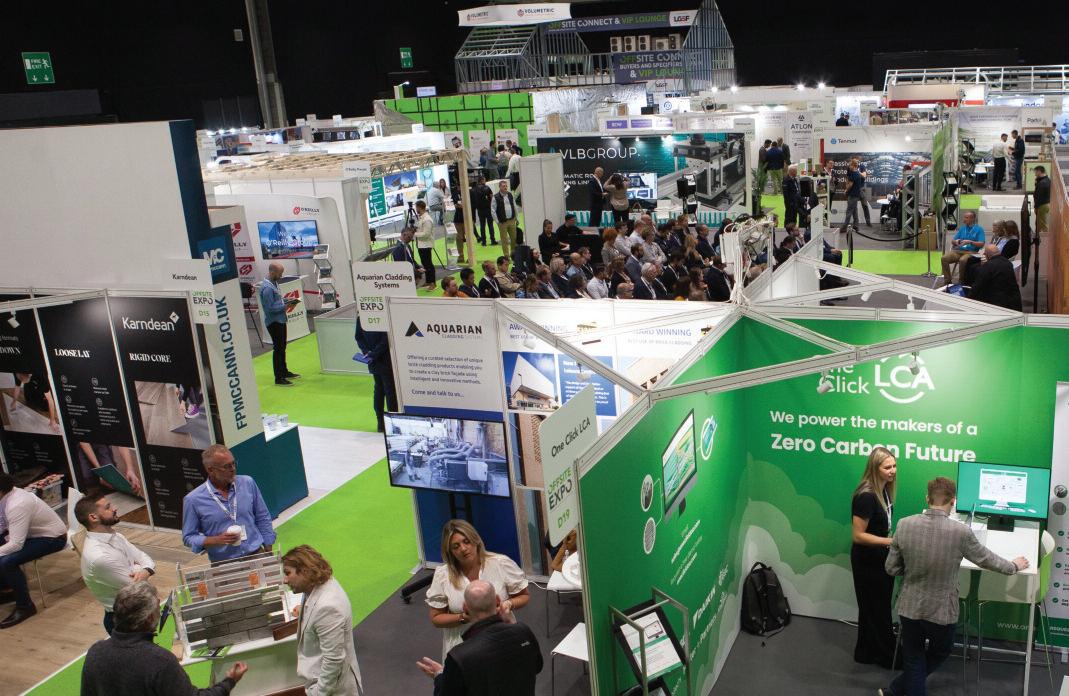
Attendees will be able to take advantage of the expertise and knowledge of more than 150 offsite manufacturers and suppliers and hear from more than 100 speakers in the Explore Offsite CPD Masterclasses, as well as free consultations with offsite experts There will also be a dedicated Offsite Connect buyers and specifiers forum, with more than 100 construction industry professionals participating n Offsite Expo will take place on 17th and 18th September 2024 at the Coventry Building Society Arena. For more information, visit www.rdr.link/laq028

Adver tisement index
Here is a useful summary of all the adverts that appear in this issue of Local Authority Building & Maintenance.
Each is listed with its page number and a direct URL that will get you straight to the relevant online information
A. Proctor Group ......................................................(page 43/IBC)
www rdr link/LAQ100
Aico Ltd ................................................................................(page 4)
www rdr link/LAQ101
Andeas Stihl Ltd (page 9)
www rdr link/LAQ102
BPD (page 32)
www rdr link/LAQ103
Geberit Ltd (page 24)
www rdr link/LAQ104
Horne Engineering Co Ltd (page 24)
www rdr link/LAQ105
Kohler Mira (page 27)
www rdr link/LAQ106
LABM Online ............................................................(page 44/OBC)
www rdr link/LAQ107
Marley Ltd ..........................................................................(page 31)
www rdr link/LAQ108
ProBuilder Live (page 2/IFC)
www rdr link/LAQ109
Rockwool UK Ltd (page 35)
www rdr link/LAQ110
Samuel Heath & Sons (page 18)
www rdr link/LAQ111
Sunray Timber Fire Doors ..............................................(page 20)
www rdr link/LAQ112
MODULAR & OFFSITE CONSTRUCTION ROUND-UP 4 2 I L A B M M A R C H / A P R I L 2 0 2 4

F o r a l l t h e l a t e s t n e w s a n d v i e w s c h e c k o u t
l a b m o n l i n e . c o . u k
L O C A L A U T H O R I T Y B U I L D I N G& M A I N T E N A N C E
L A B M ’s w e b s i t e o f f e r s a n e s s e n t i a l i n f o r m a t i o n r e s o u r c e f o r l o c a l a u t h o r i t y a n d h o u s i n g a s s o c i a t i o n s p e c i f i e r s , a n d a n y o n e i n v o l v e d i n t h e c o n s t r u c t i o n , r e f u r b i s h m e n t a n d m a i n t e n a n c e o f s o c i a l a n d a f f o r d a b l e h o u s i n g , s c h o o l s , h e a l t h c a r e f a c i l i t i e s a n d p u b l i c s e c t o r b u i l d i n g s O n t h e w e b s i t e y o u ’ l l f i n d d e t a i l s o n a l l t h e l a t e s t f u n d i n g a n d r e g u l a t o r y u p d a t e s , s e c t o r a n n o u n c e m e n t s , c o n t r a c t a w a r d s a n d i n d u s t r y e v e n t s . We s h a r e i n s i g h t a n d o p i n i o n f r o m c o m m e n t a t o r s a c r o s s t h e s u p p l y c h a i n , f e a t u r e i n - d e p t h p r o j e c t c a s e s t u d i e s a n d i n o u r P r o d u c t s s e c t i o n , s h o w c a s e n e w p r o d u c t i n n o v a t i o n s , t e c h n o l o g i e s a n d c o n s t r u c t i o n s o l u t i o n s








D o n ’ t f o r g e t t o f o l l o w u s o n Tw i t t e r @ la b mm a g a n d o n L i n k e d I n a t w w w. li nke d in. c o m/ c o mp a ny / lo c al -a u t ho r it y -b u il di ng - m ai nt e na nce f o r a l l t h e l a t e s t s t o r i e s




































































 Clyde Radiators Mini LST is easy to clean and a poor harbour for dust and micro-organisms
Clyde Radiators Mini LST is easy to clean and a poor harbour for dust and micro-organisms


























































































